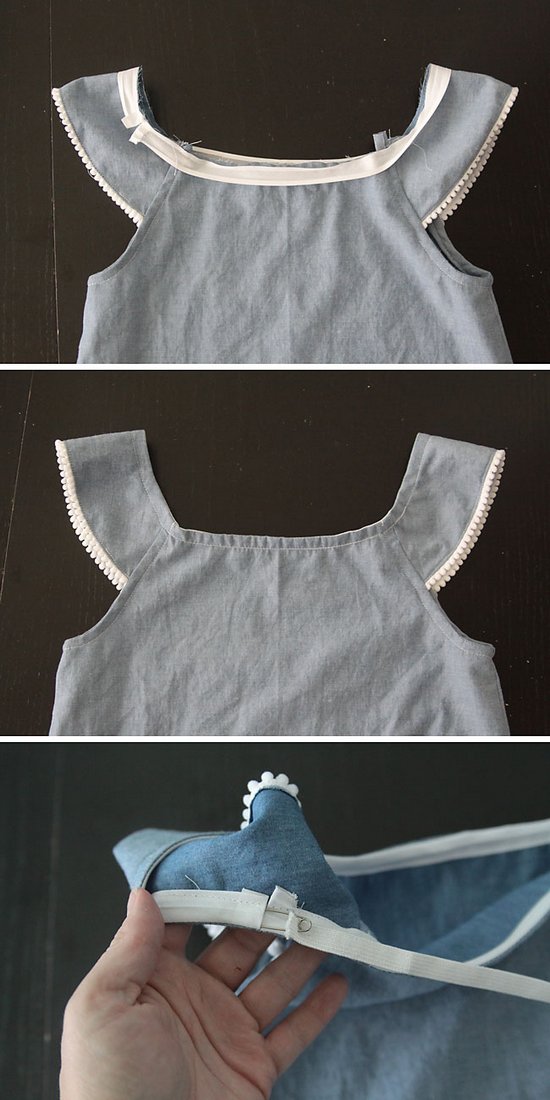Children jumpsuits. Winter overalls for boys with a zipper and warm fleece.
Authors of the article:
Hello, Zimushka-winter!
For children, the new arrival of winter means new fun, new experiences! The quality of these childhood experiences is directly proportional to parental responsibility. In order for a child to have a successful walk, first of all, he needs appropriate clothing. The most suitable option for winter games snowball fights, sledding or skiing - this, of course, overalls.
Overalls will reliably protect the child from the winter cold, provide comfort and freedom of movement.
We offer you pattern, according to which you can sew a jumpsuit like for girl, so and for boy.
Ready-made pattern for children's winter overalls
Height 110cm
Bust circumference 56cm.
Authors of the article: Valentina Nivina Alexander Nivin
Rompers. Finished pattern.
Winter is the time for country skiing, ice skating, sledding, fun games snowballs. For children to feel comfortable outside, they need appropriate clothing - comfortable, functional, and not restricting movement.
Ready-made pattern for children's winter overalls, offered to your attention is designed for height 110cm, chest circumference 56cm.
Jumpsuit (with insulation) straight silhouette, optimally voluminous, with hood, with leaf pockets, with elastic or drawstring at the waist, zipper fastening. The sleeves and legs at the bottom are also gathered with elastic or cuffs.
Author of the work: Kuryshkina Yu.A.
To sew the overalls I needed:
- ready-made overalls pattern (we are 6.5 months old, but I sewed a size 74 overalls for growth);
- 1.2 m of main fabric (I used raincoat fabric);
- 1.2 m of fabric for lining (as lining fabric I used fleece);
- 2 m of insulation (our winters are cold, so I made two layers of double synthetic padding);
- 2 permanent zippers 50 cm long;
- 1 cord 80 cm;
- elastic cord 1.5 m;
- 6 clamps and 6 cord ends.
I added boots and mittens to the overalls pattern (patterns are given in actual size):
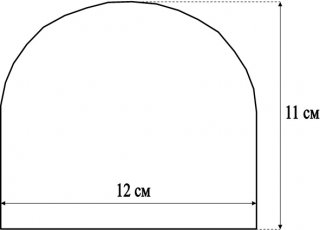

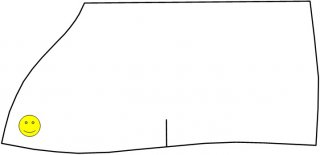
I also changed the edging of the hood and the backing for the zipper (see below)

Step 1. When cutting parts from the main fabric, I made the following seam allowances (allowances are given in cm)

When cutting out the lining parts, I made all seam allowances according to 1 cm
I cut out the backing for the zipper the same way from both raincoat fabric and fleece.
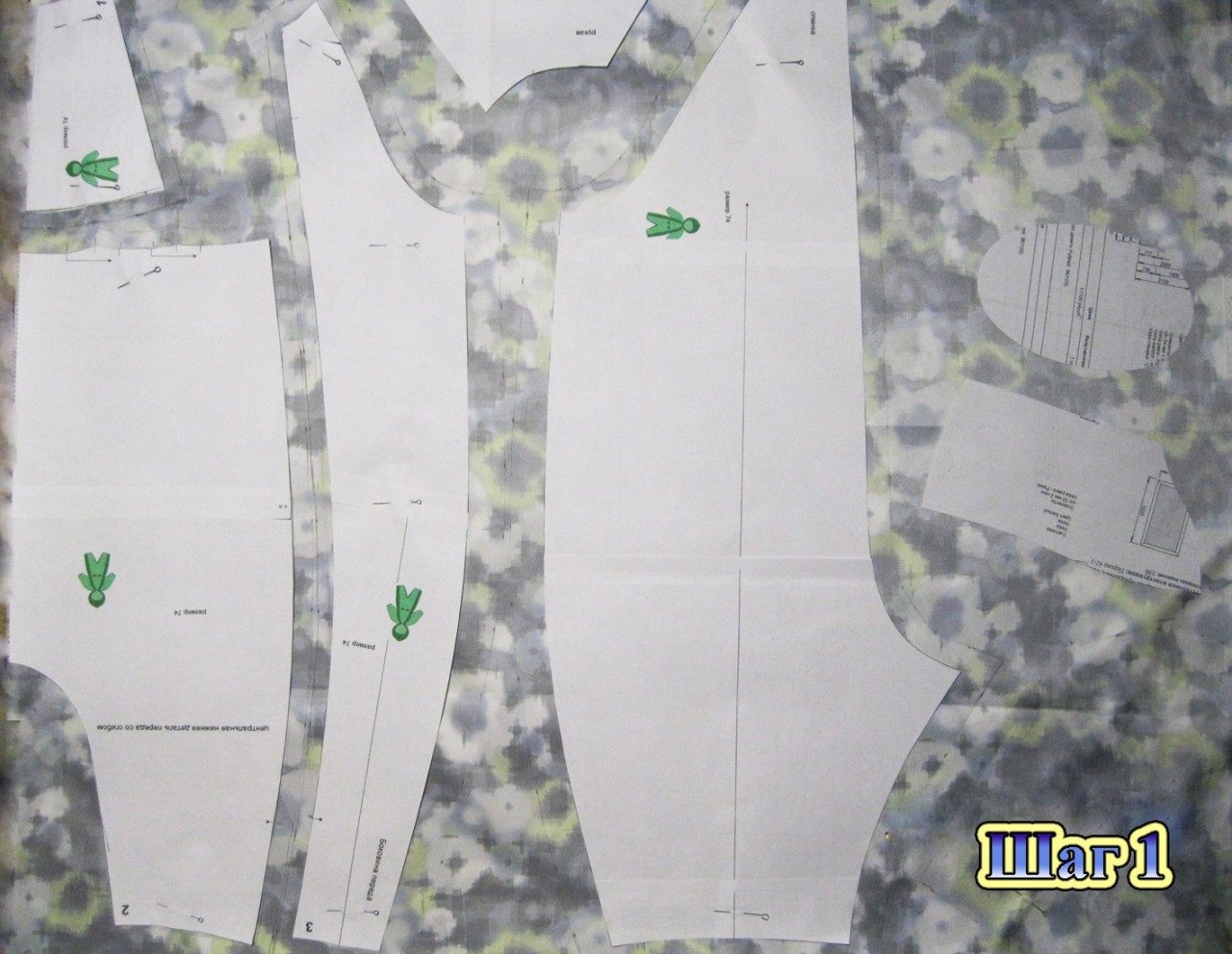
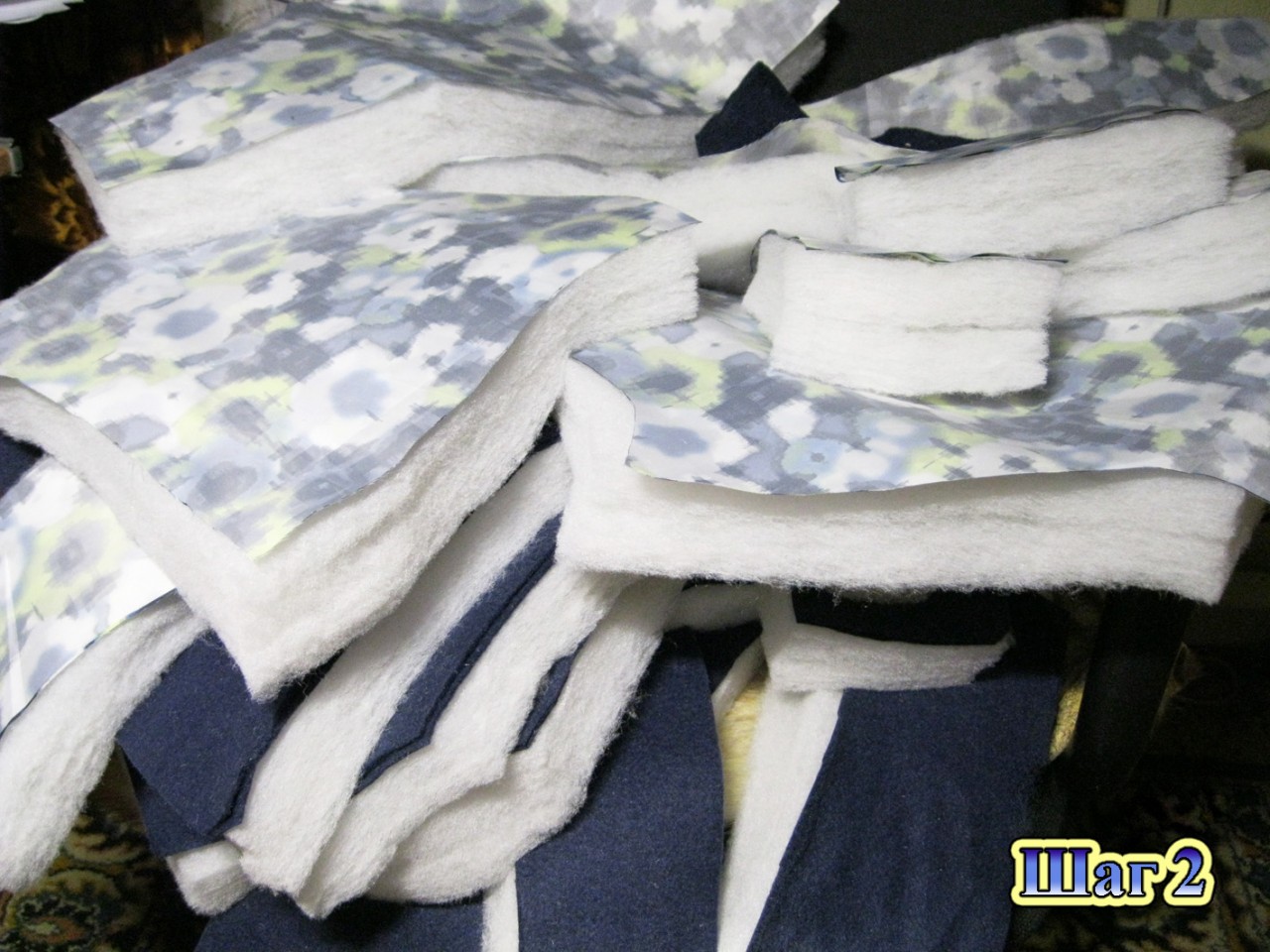
Step 2. At the next step, I placed the cut out parts (both from the main fabric and the lining parts) onto the padding polyester and cut them out exactly along the contour. Each detail was insulated with synthetic padding. For the convenience of sewing in the zipper, I did not cut out the backing for the zipper from padding polyester; it is better to fill it with padding polyester later.
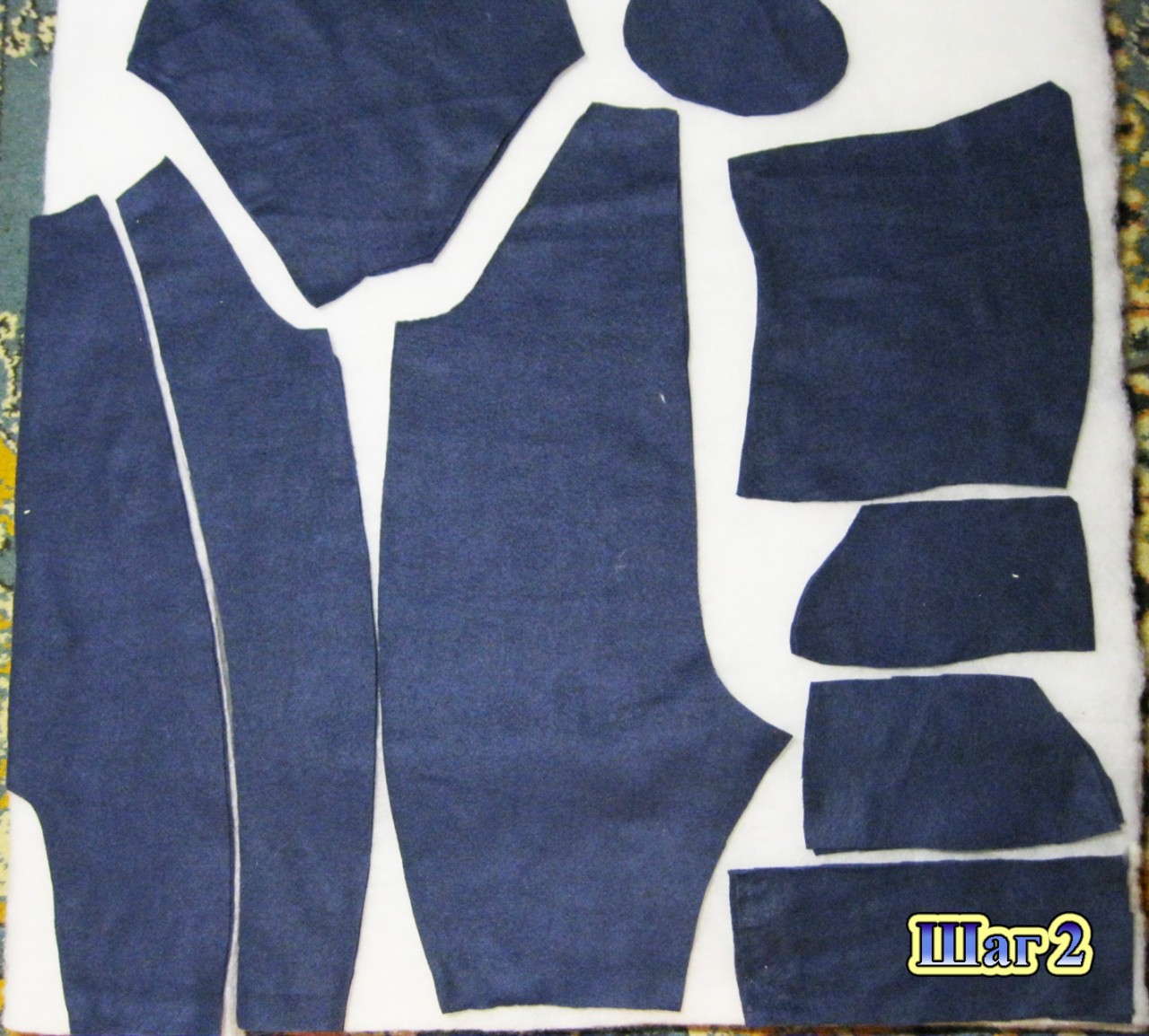
Step 3. Since I used raincoat fabric as the main fabric, and it slides over the padding polyester, it is necessary to baste all the parts from the raincoat fabric along the edge so that the padding polyester doesn’t get lost when sewing.
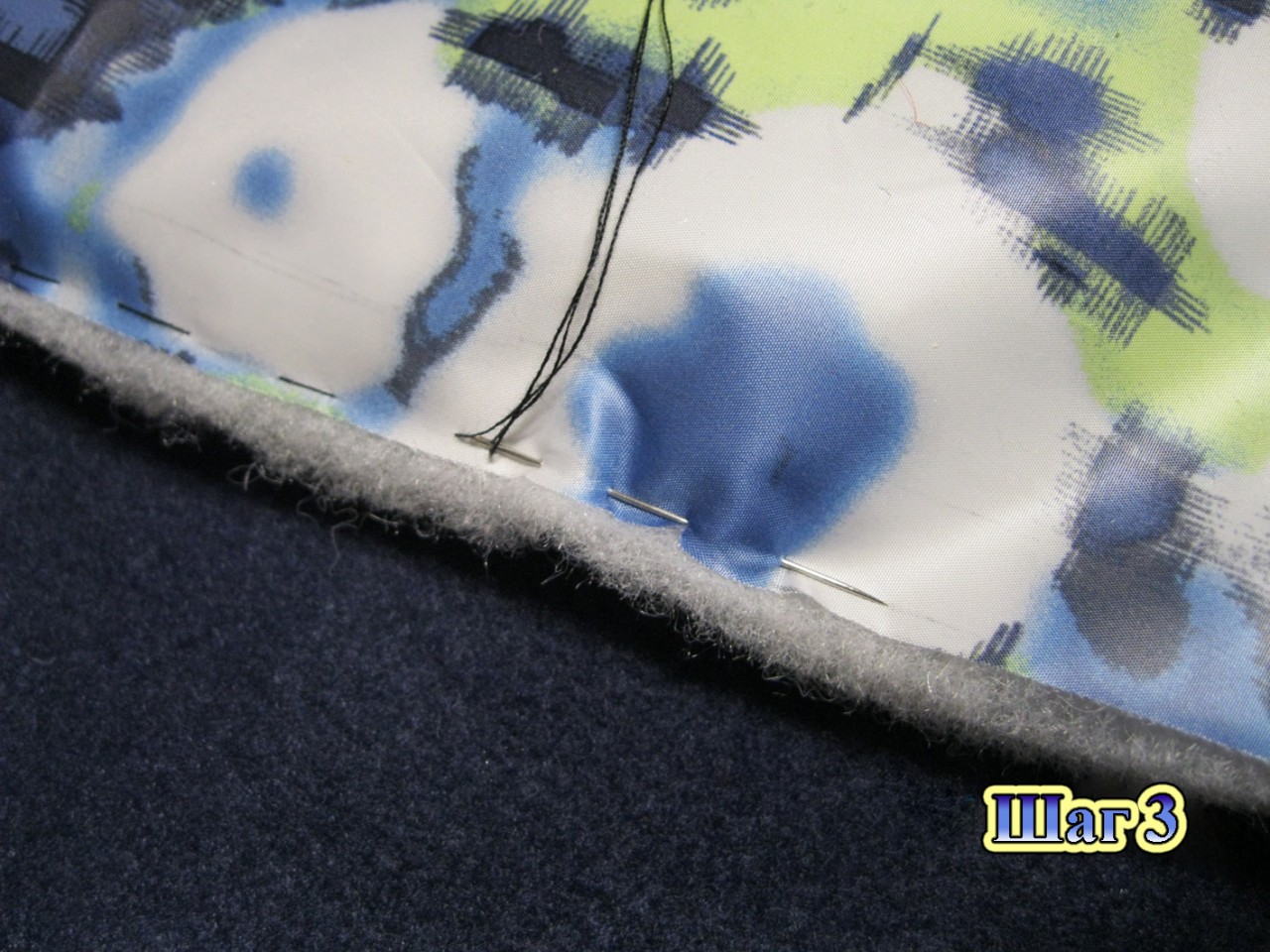
Step 4. Now you need to cut off the excess padding polyester on each part.
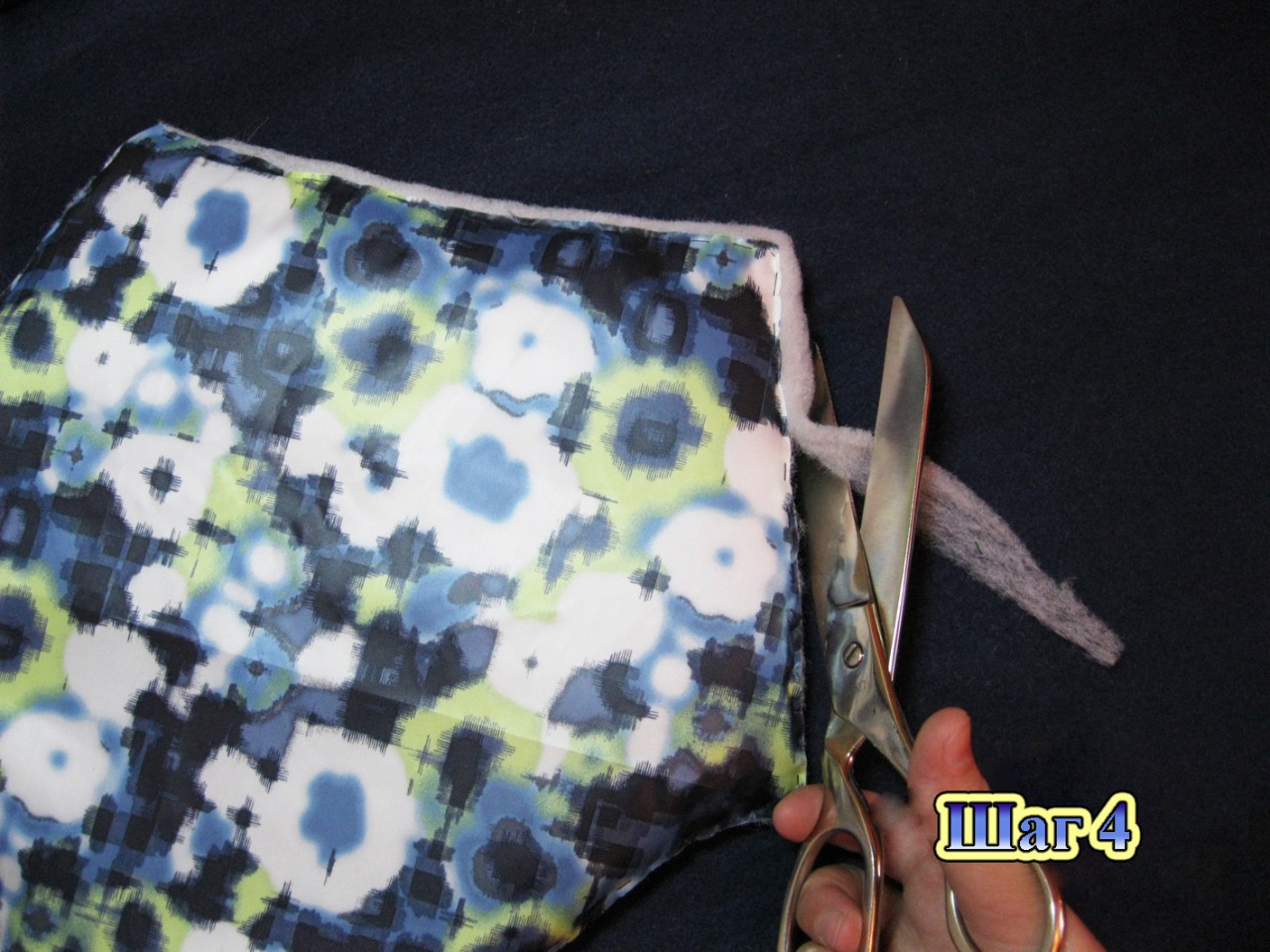
Step 5. We lay and baste the folds on the central lower part of the front with a fold, connect this part with the front yoke.
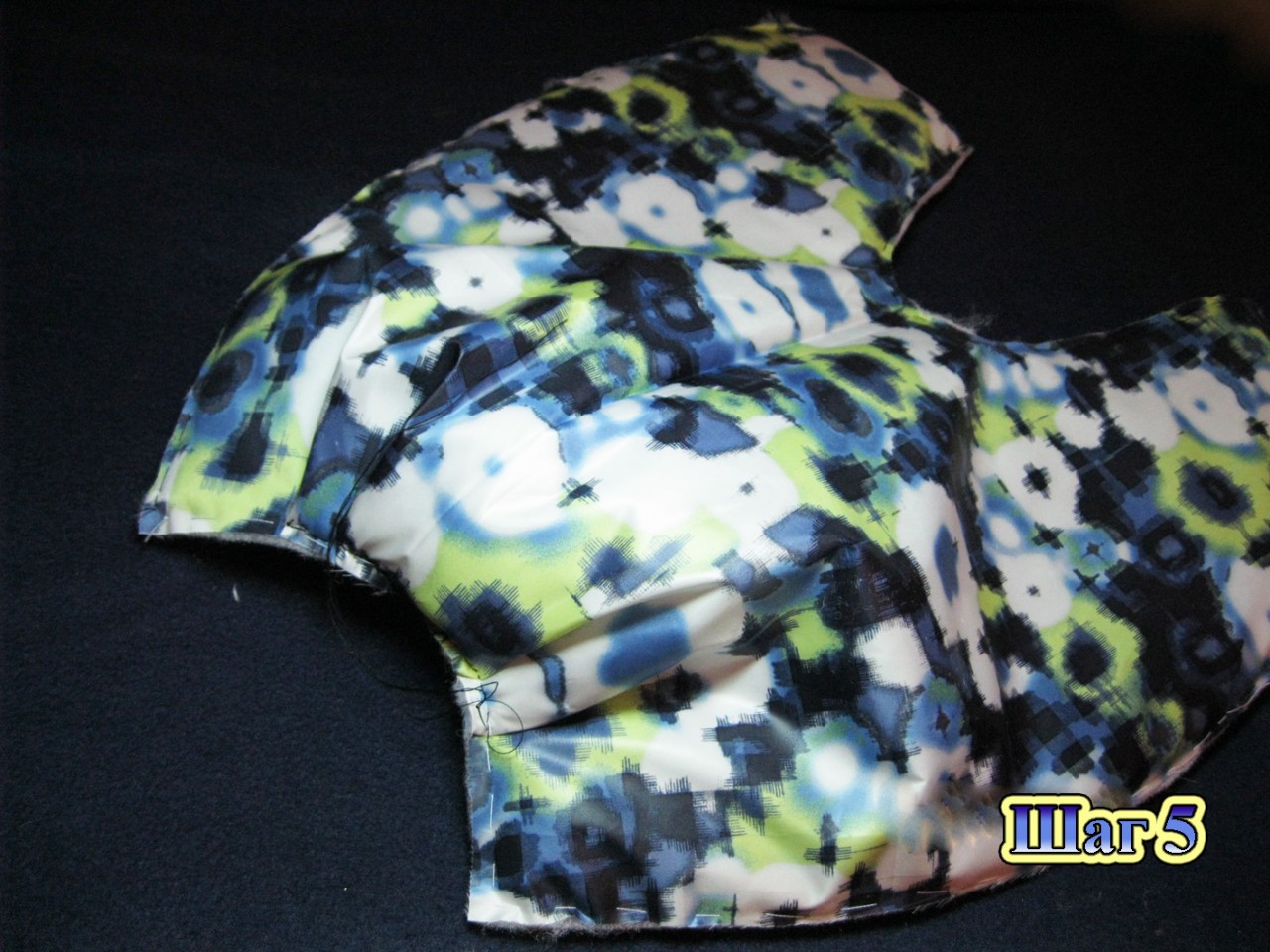
Step 6. We attach strips of fleece to the resulting central front part to the edges (where the zipper will be located) (the length of the strip is slightly longer than the length of the zipper, the width is 3.5–4 cm). I did this for the convenience of inserting the zipper, and then to close the zipper so that the heat does not escape from the overalls.

Step 7 Similarly, we attach the same strips of fleece to the sides of the front to the edges (where the zipper will be located)
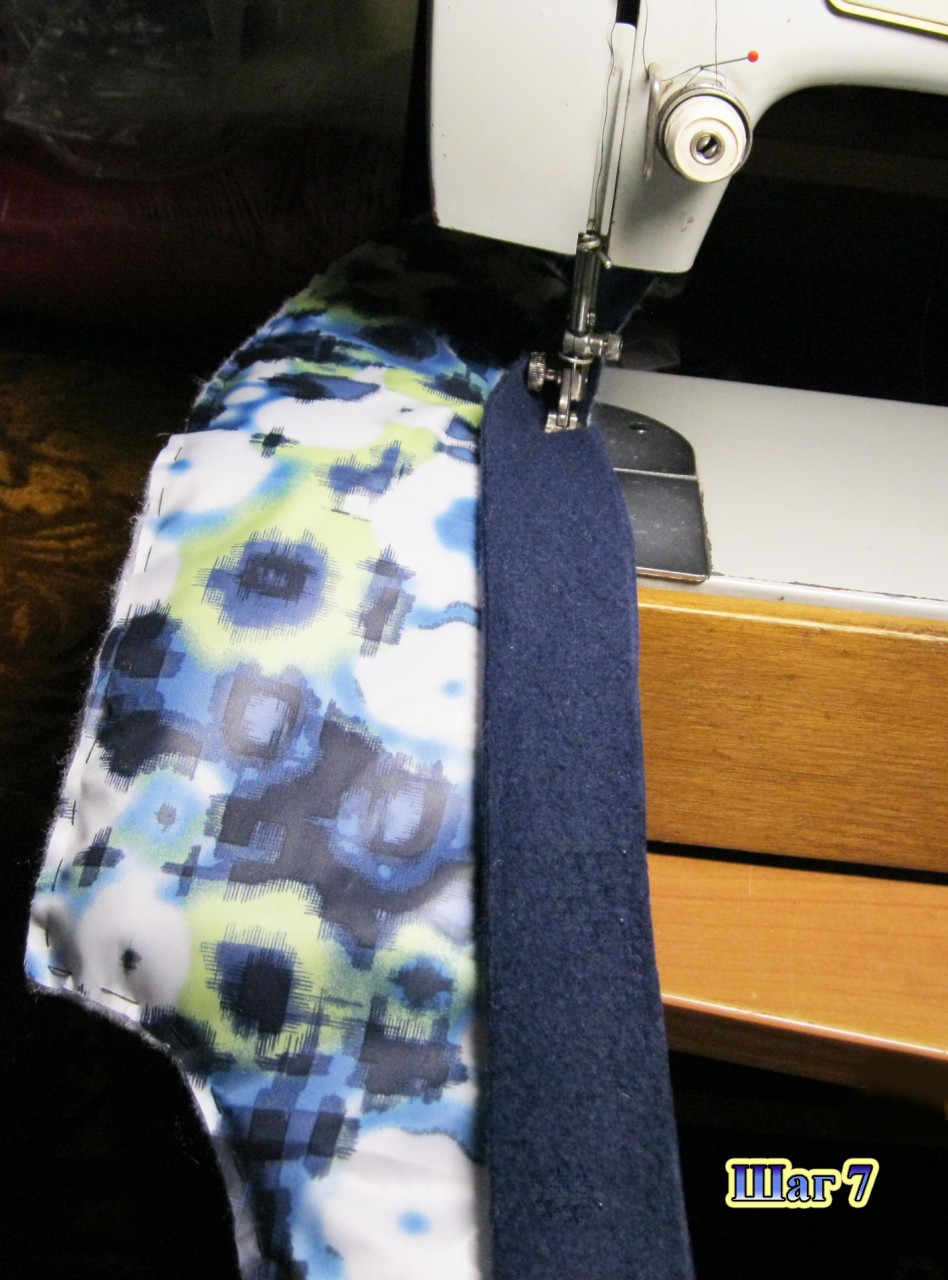
Step 8 Now we connect the sides of the front and the central front part (along the seams that are located below the cut for the zipper, they are marked in red in the photo). Here's what happens:
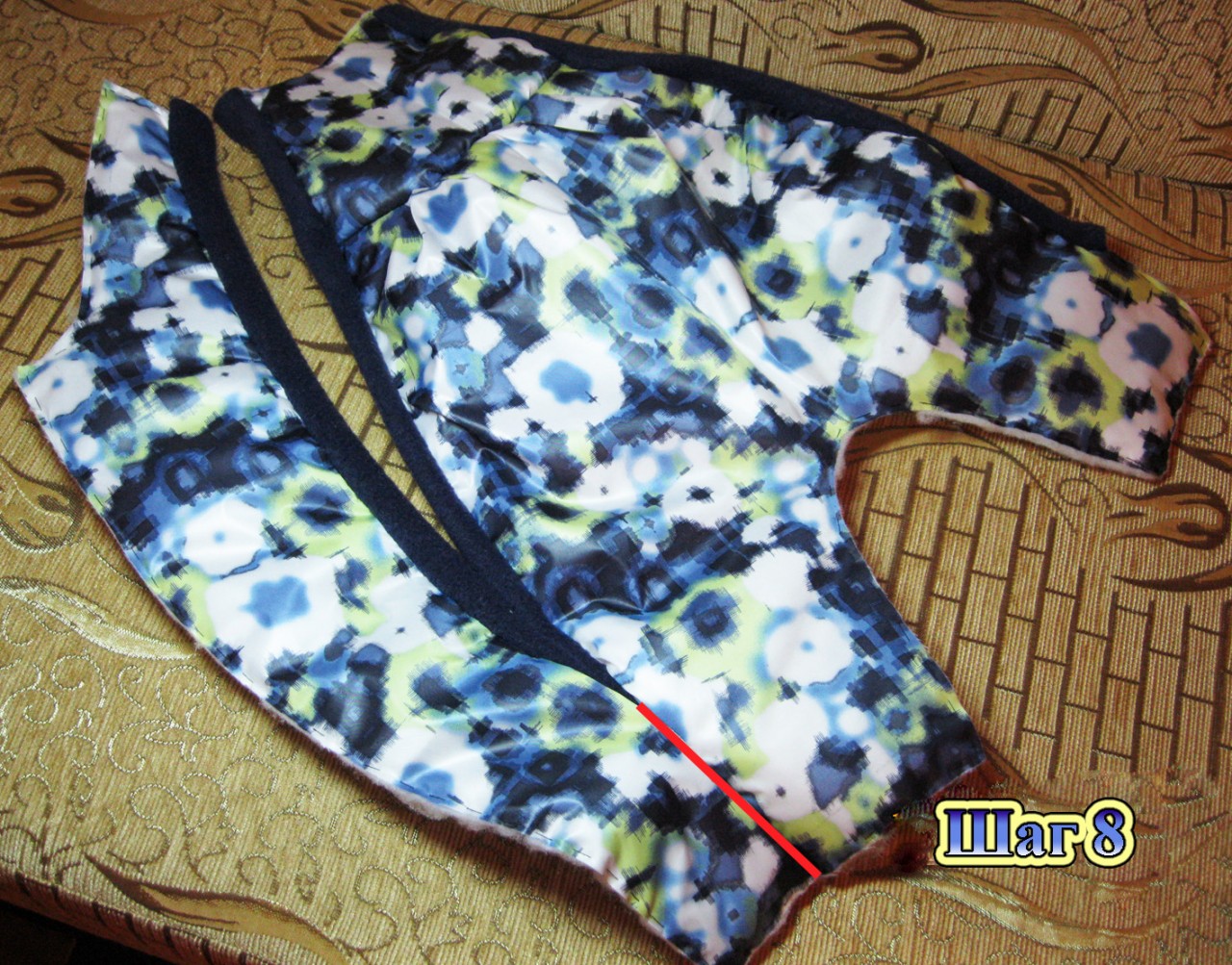
Step 9 We make cuts for the zipper. In the photo I put a zipper into the cut to show how it will be sewn in.
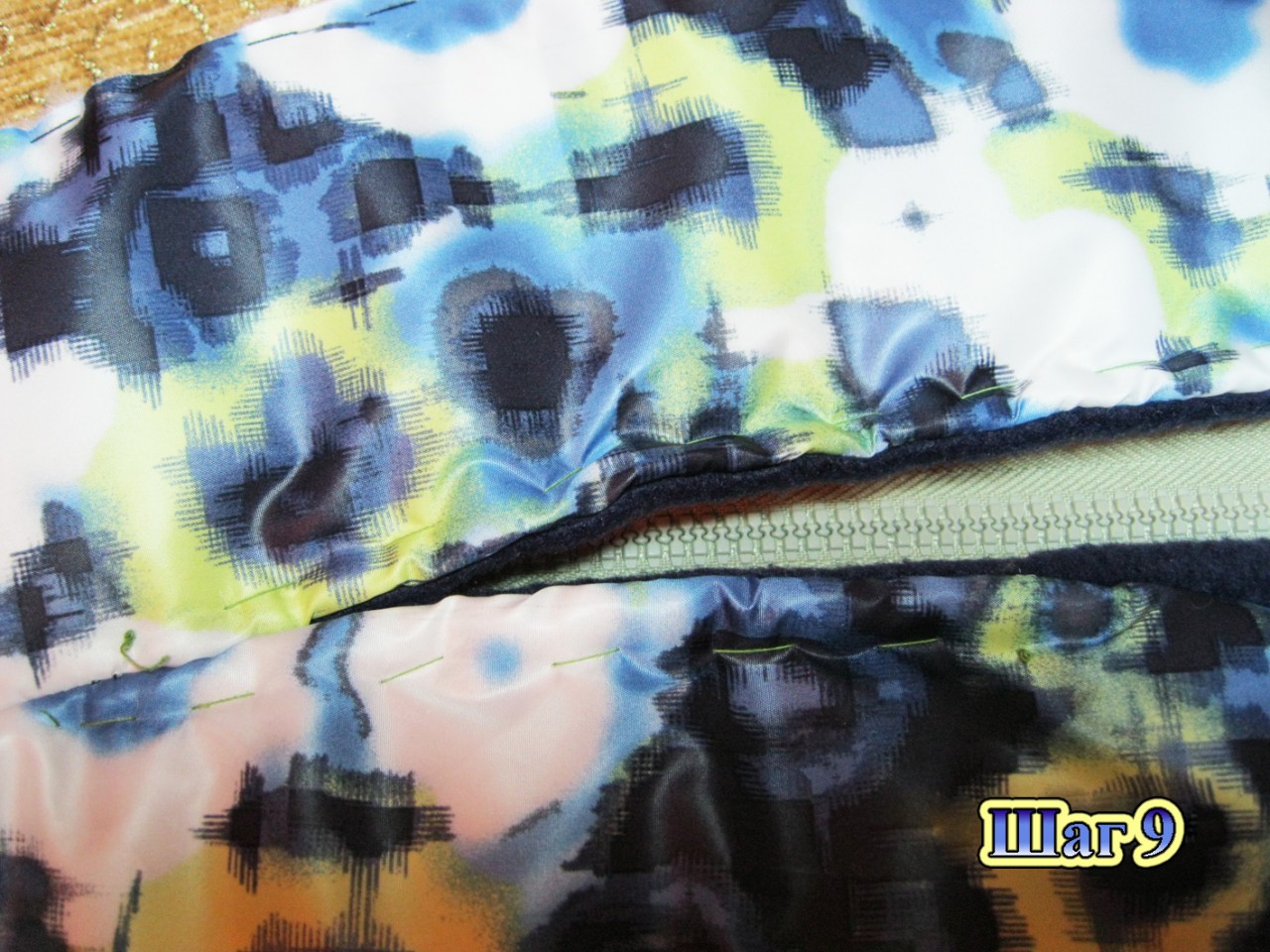
Step 10 Sew the back pieces along the middle seam. I stitched an elastic band to the back, stepping back from the edge of the armhole about 2-2.5 cm. The length of the elastic is 25 cm. Then you can connect the front and back parts of the overalls along the middle seam between the legs. There is no need to sew the side seams yet, they will be sewn together with the sleeve!
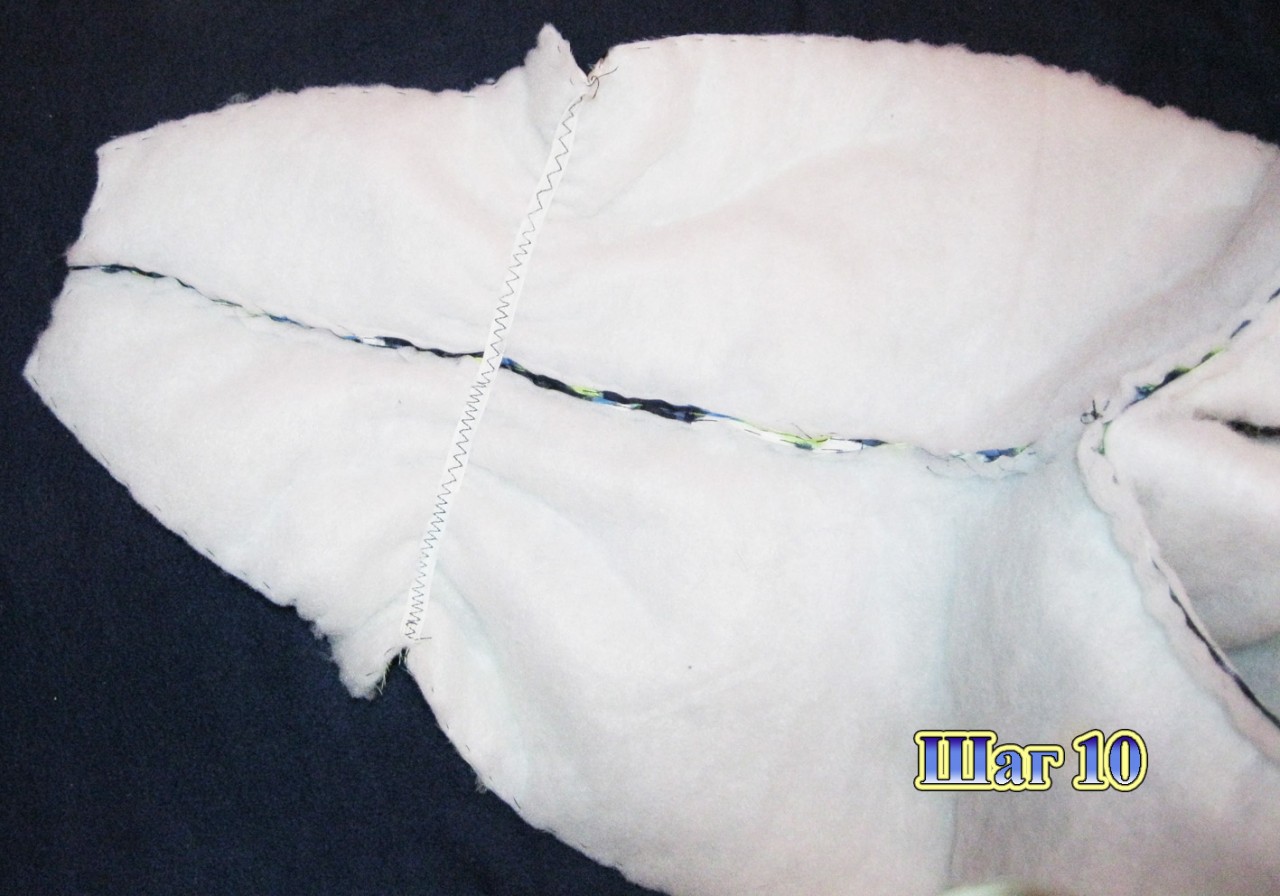
Step 11 We sew the sleeves to the front and back parts of the overalls. We fold the overalls and sew the sleeve seam and the side seam of the overalls (in one seam). Unfortunately, I didn’t take a photo of this stage.
Step 12 Let's start sewing the hood. We cut out the edging of the hood (the pattern is given above). I cut it out of faux white fur and used fleece for the lining.
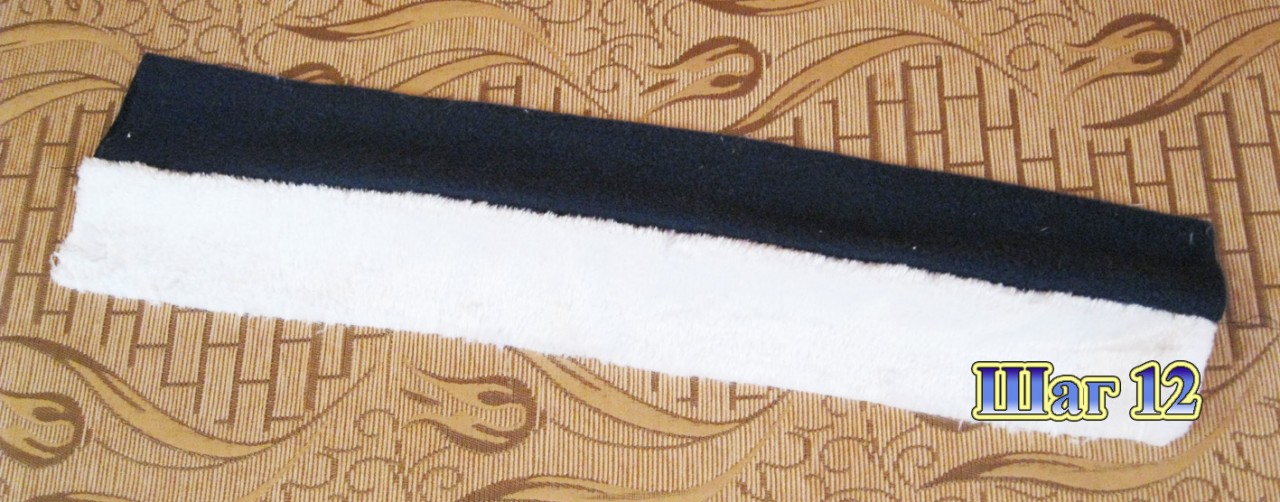
Step 13 We sew out the edging of the hood.
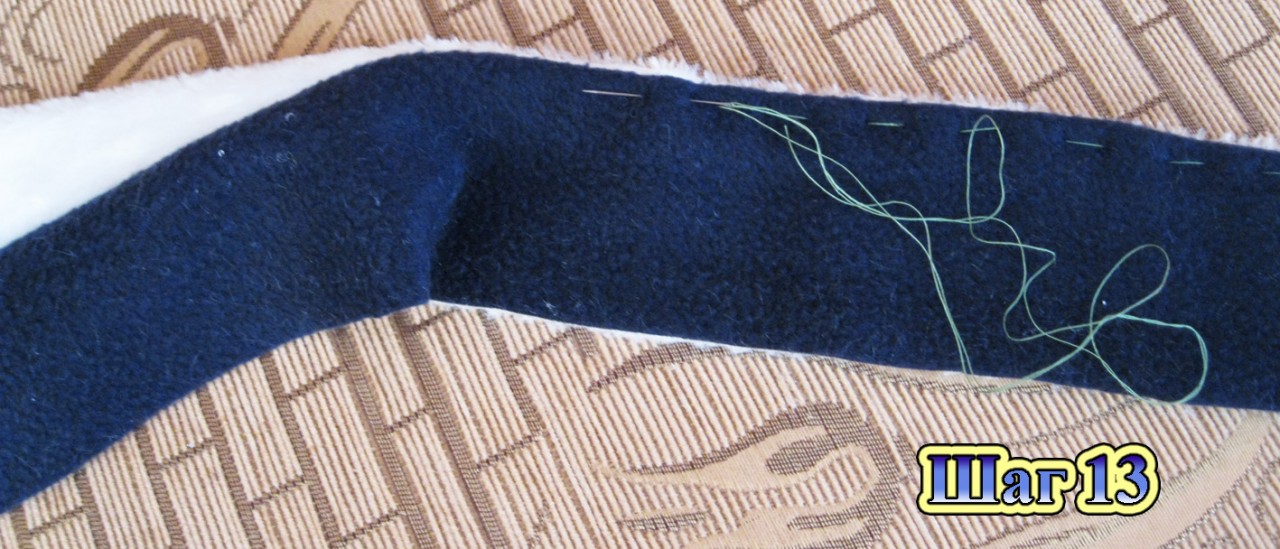
Step 14 We sew up the seam of the hood and attach the edging to it (as shown in the photo).

Step 15 We lay a machine seam, but not where we just basted, but at a distance of about 1.5 cm from the basting seam. This is necessary in order to then insert a cord into this drawstring to tighten the hood. You can make the drawstring for the lace in a different way, as it will be more convenient for you or as you think will be more rational.

Step 16 We sew down the details of the hood, cut from fleece. We place the hoods from the main fabric and from the lining one into the other with the right side inward (as shown in the photo).
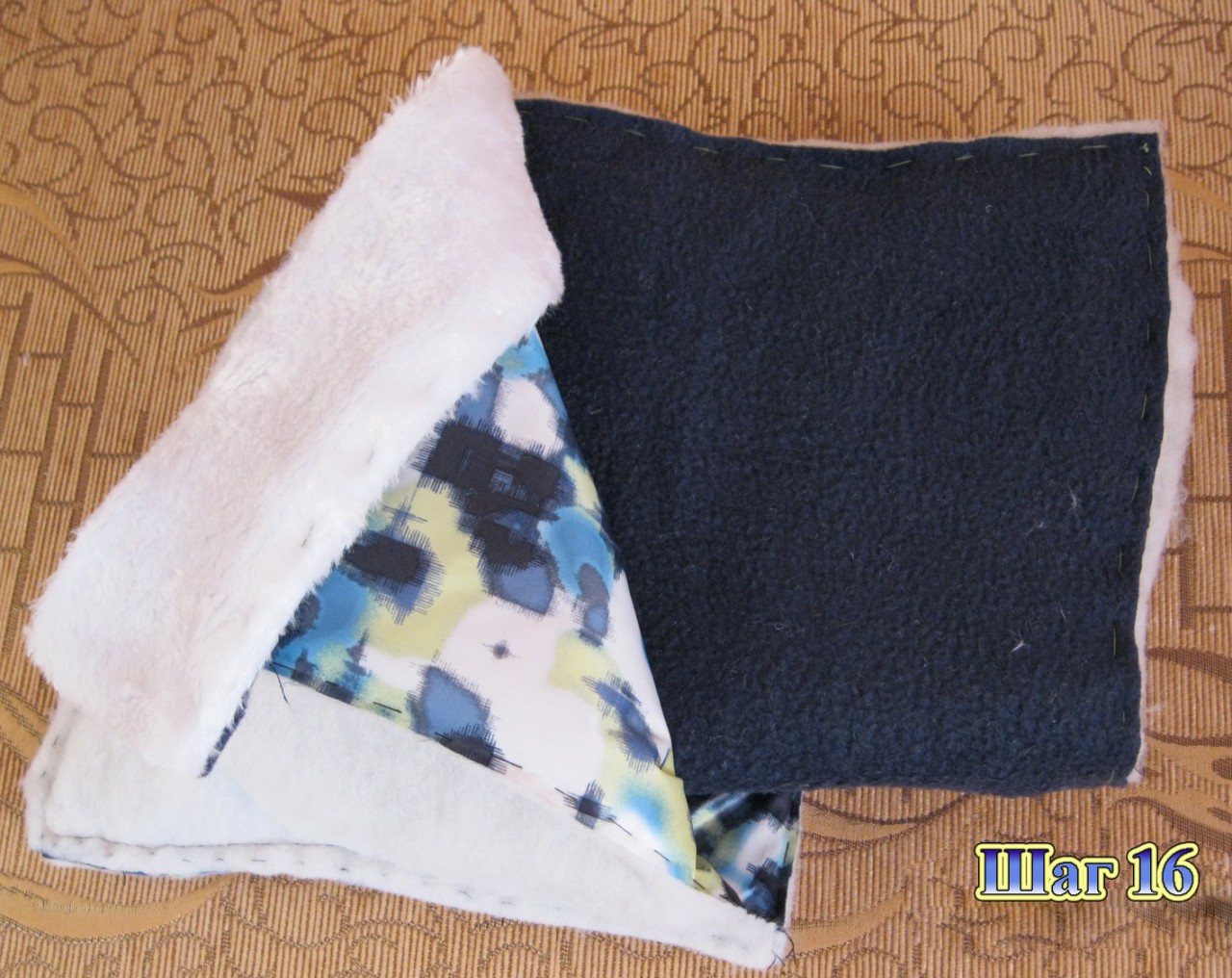
Step 17 We sweep away the details of the hood along the front edge (in the photo I am holding this place with my hand).
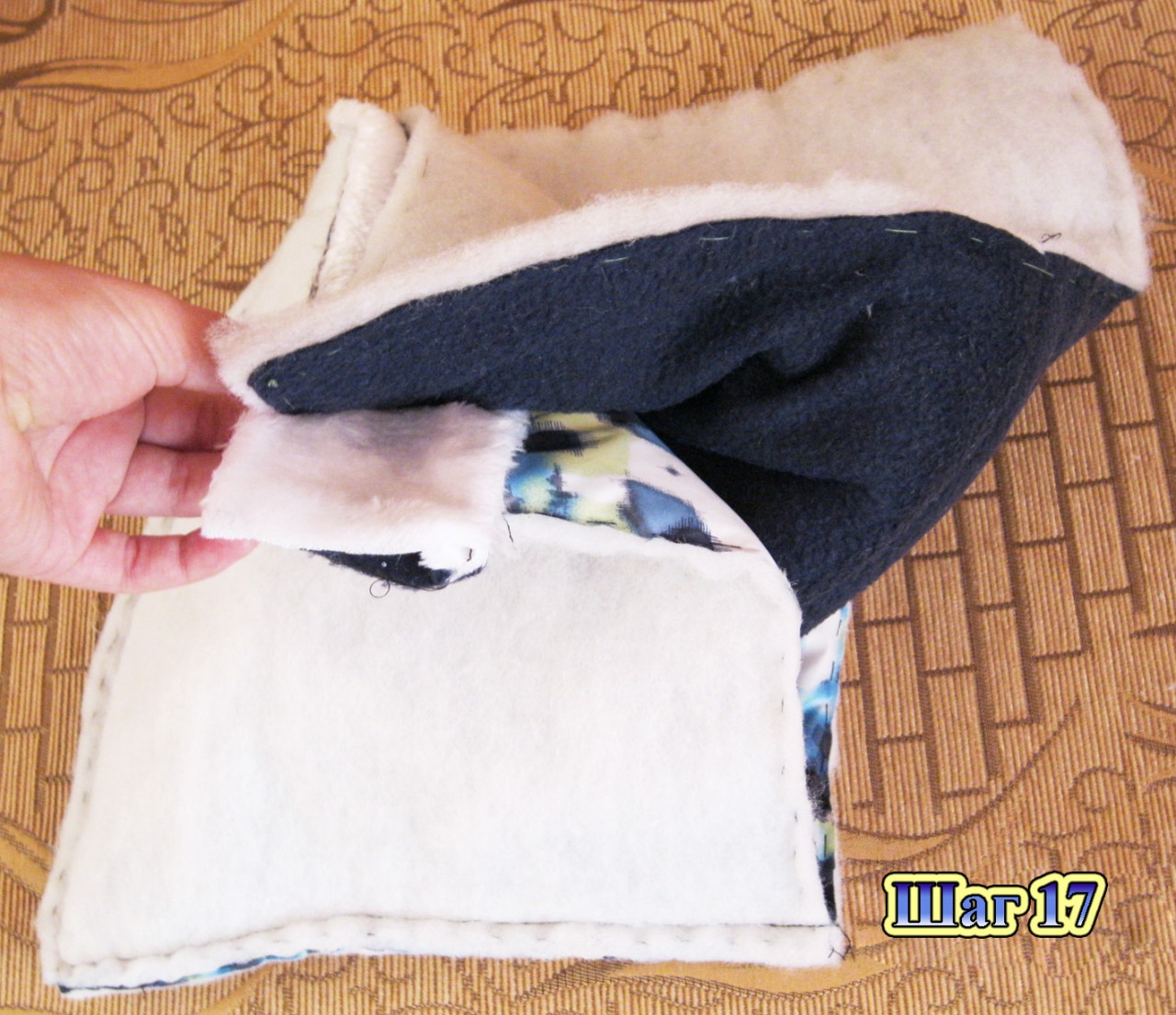
Step 18 Then you need to stitch this seam (shown in the photo with a red dotted line).

Step 19 We turn the hood inside out and this is what we got.
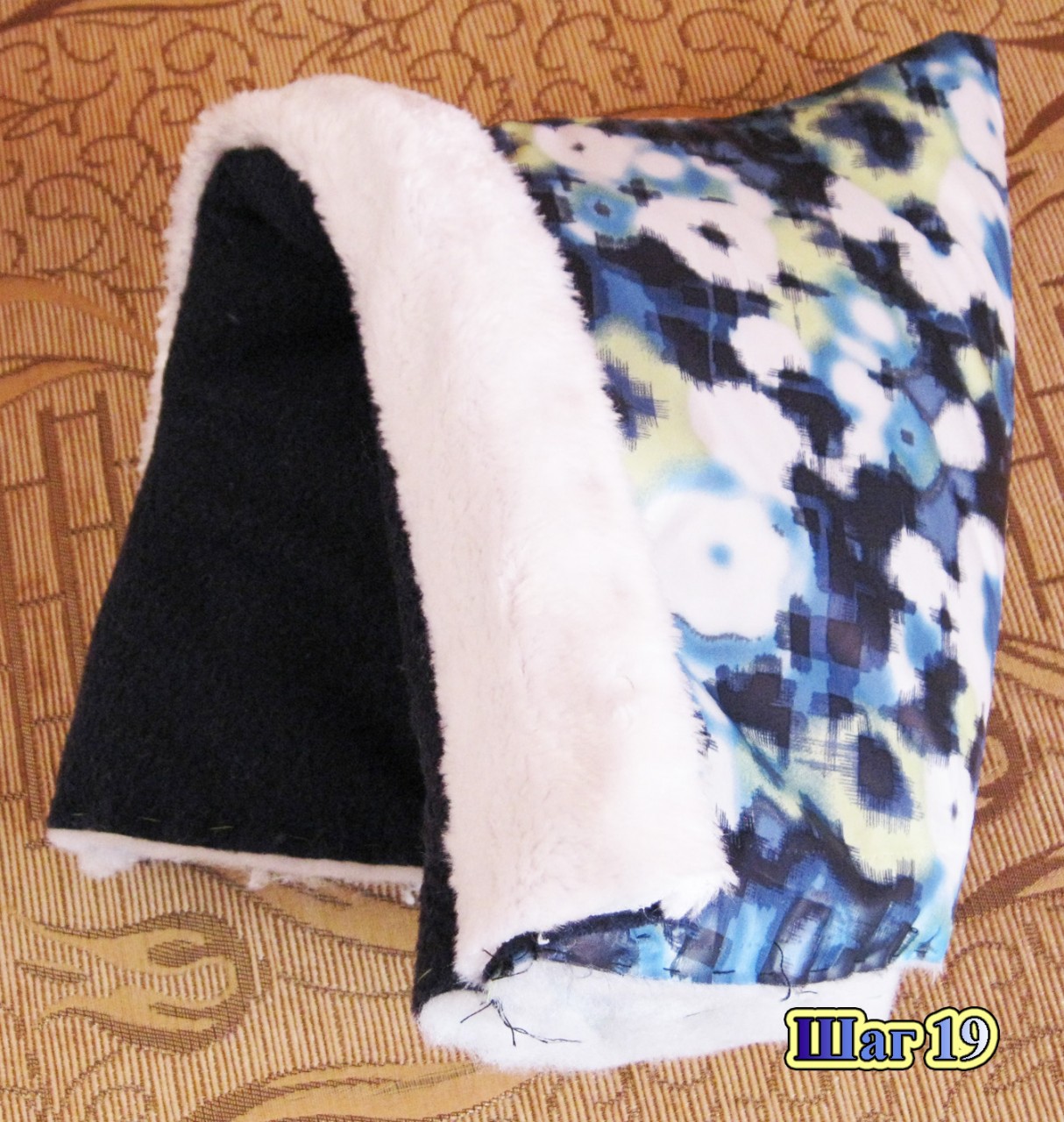
Step 20. Place the zipper backing pieces right sides together.

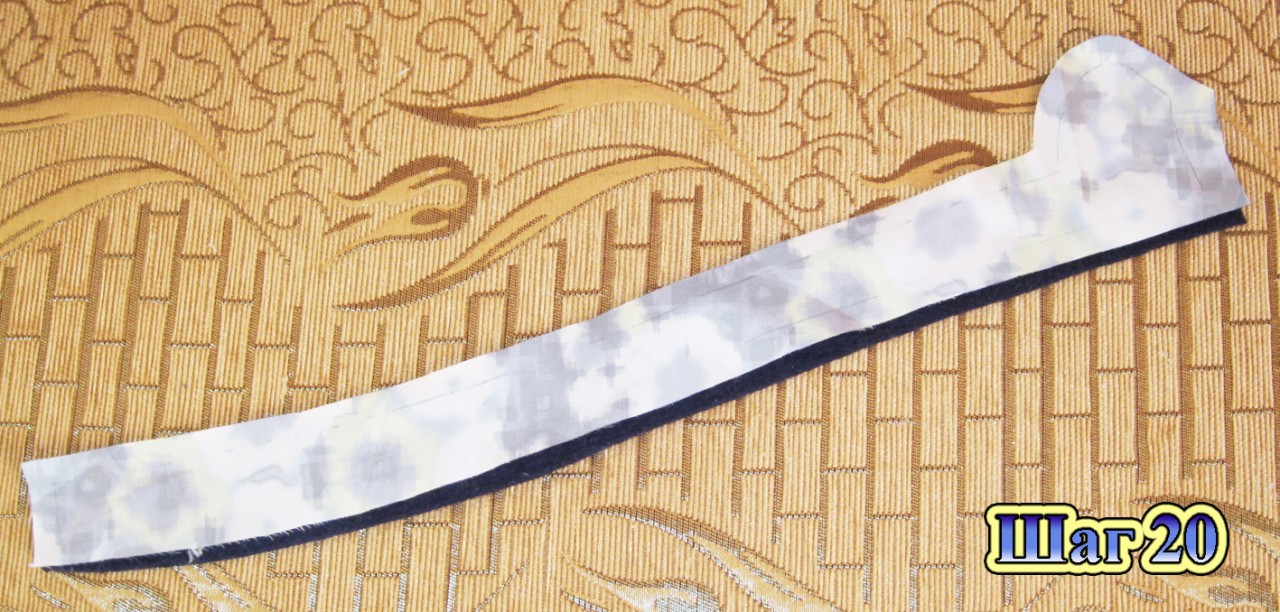
Step 21 We sew the backing for the zipper. Just don’t put a seam at the junction with the neckline; we will sew the hood there (in the photo this place is circled in red).
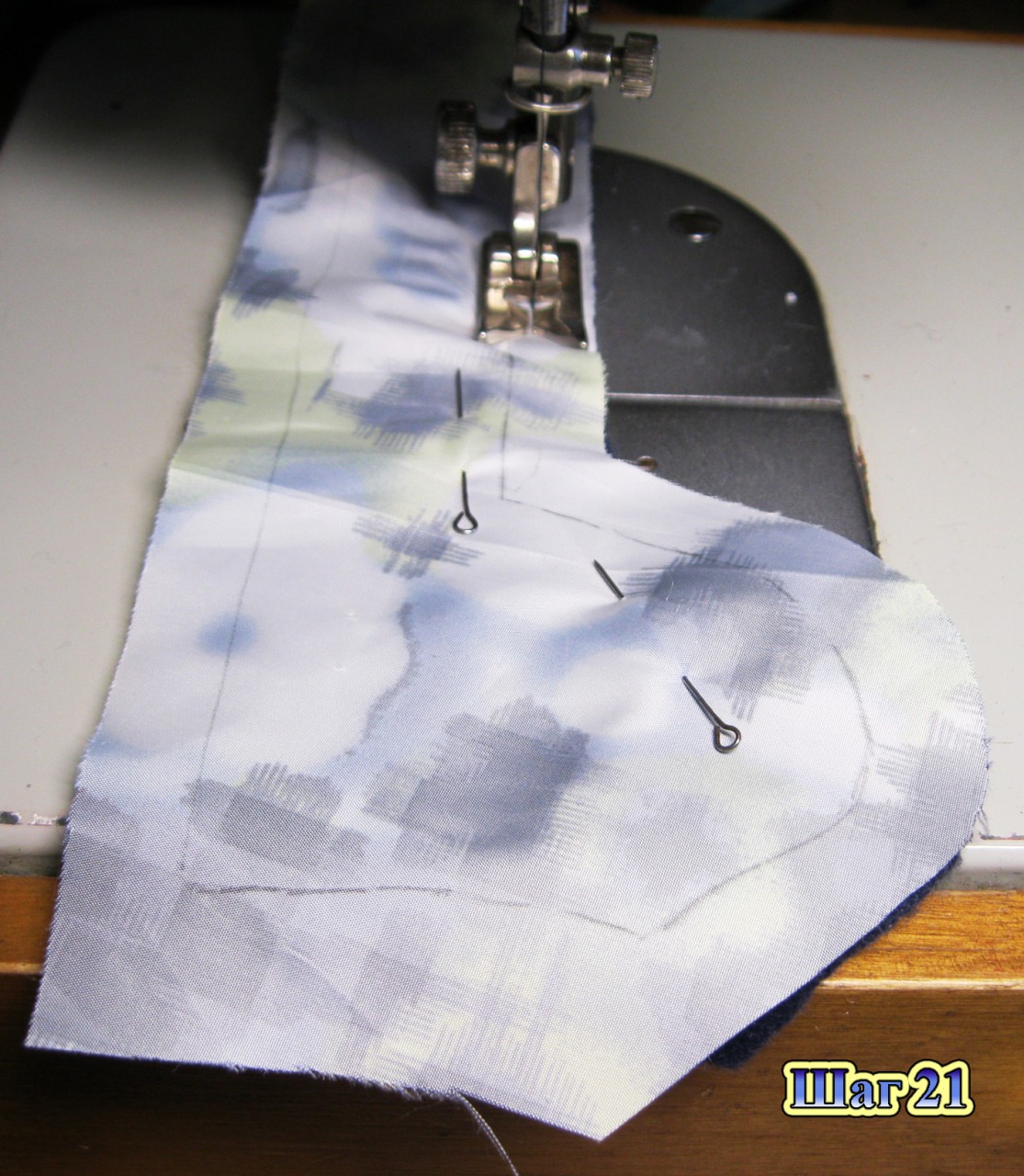
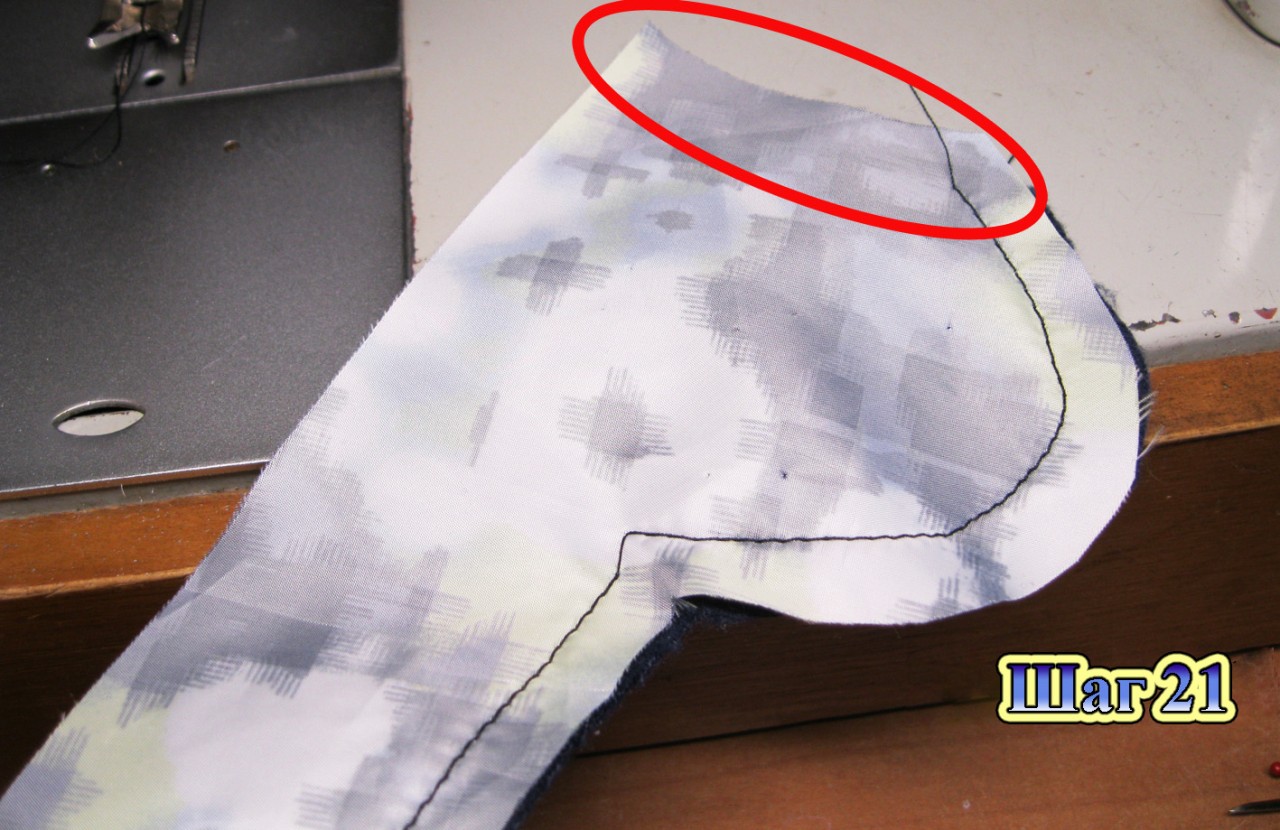
Step 22 We cut the seam allowance so that we can carefully turn it inside out.
Step 23
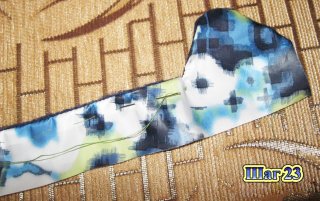
Step 24

Step 23Turn the backing right side out and baste the edge.

Step 24We combine the backing for the zipper with the hood: the front side of the backing is to the front side of the hood, the hood lining is to the backing lining. We baste the backing to the hood and stitch it together.

The result should be:
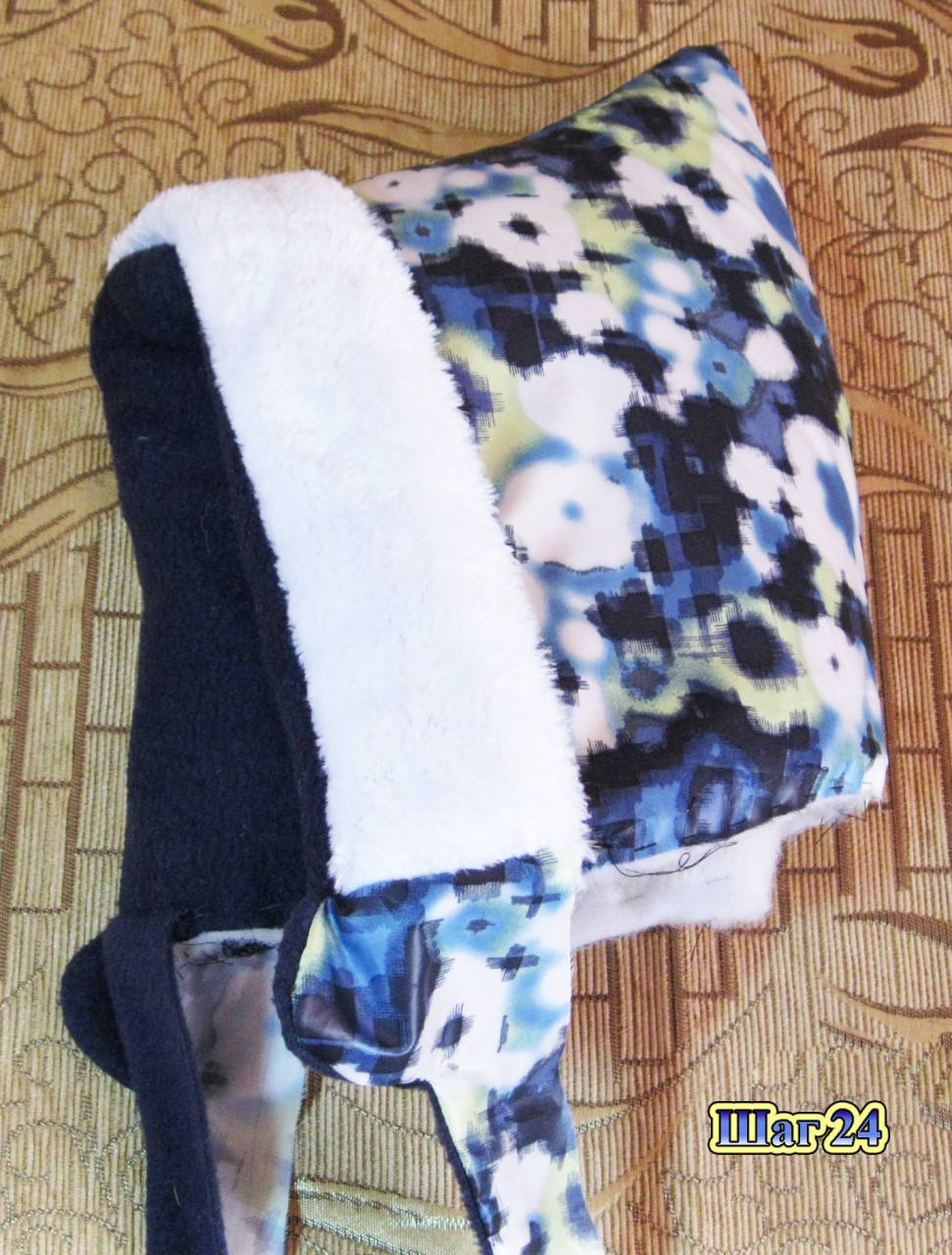
Step 25 Now we apply the front side of the hood to the front side of the overalls and baste them, then stitch them together (in the photo the seam is indicated by a red dotted line).

The junction of the hood, zipper backing and overalls:
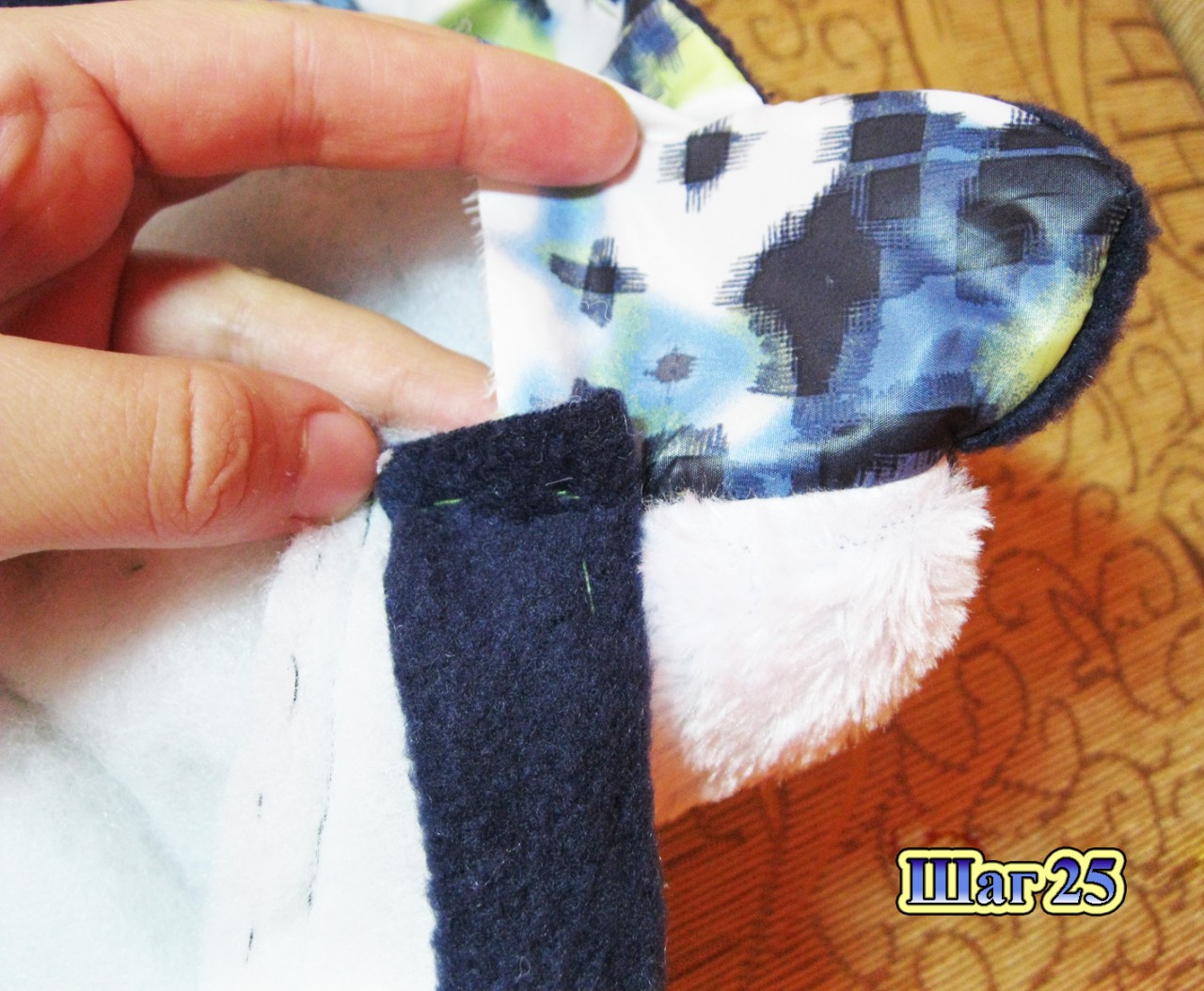

Step 26
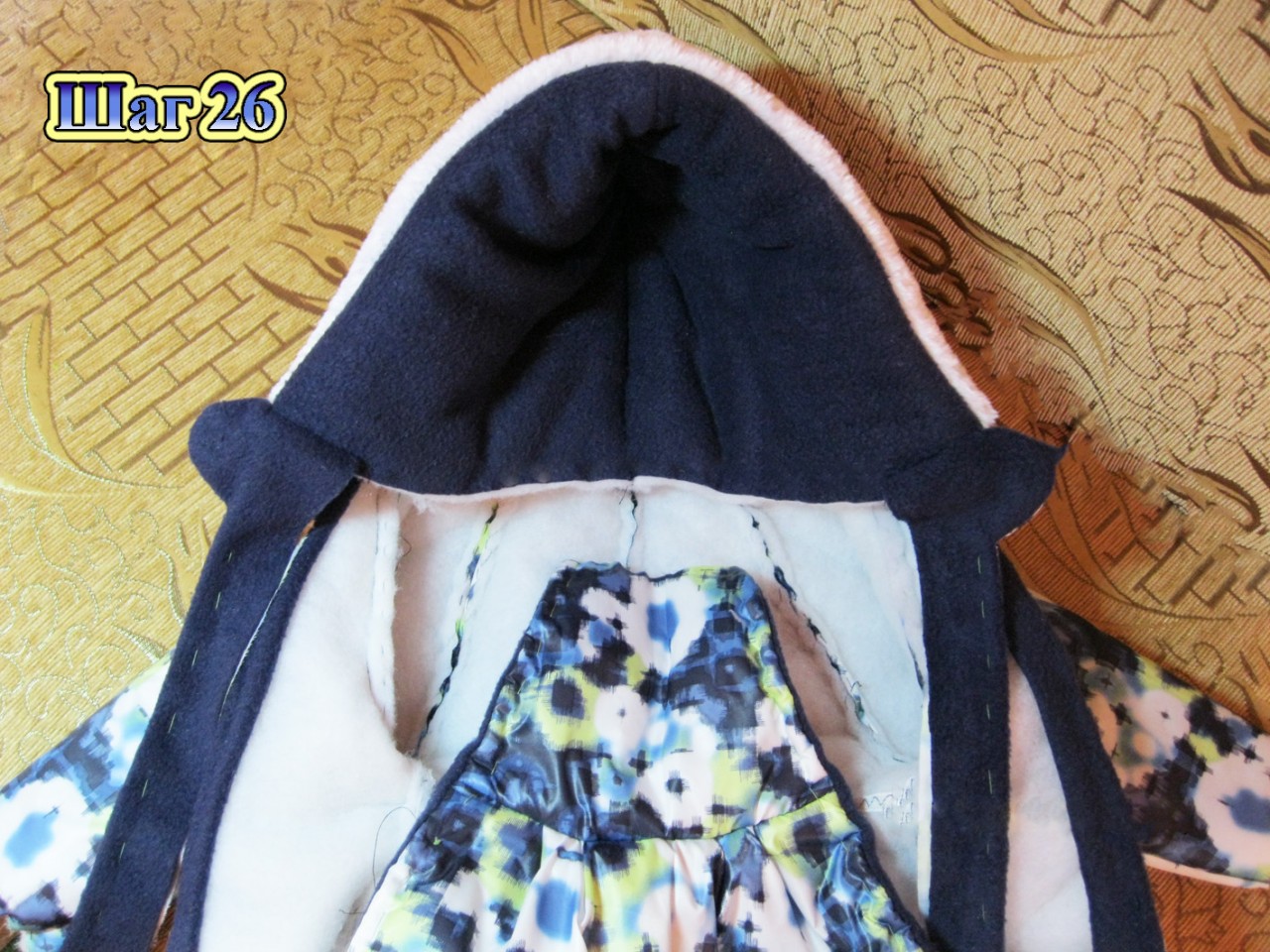
This is how the zipper will be sewn:
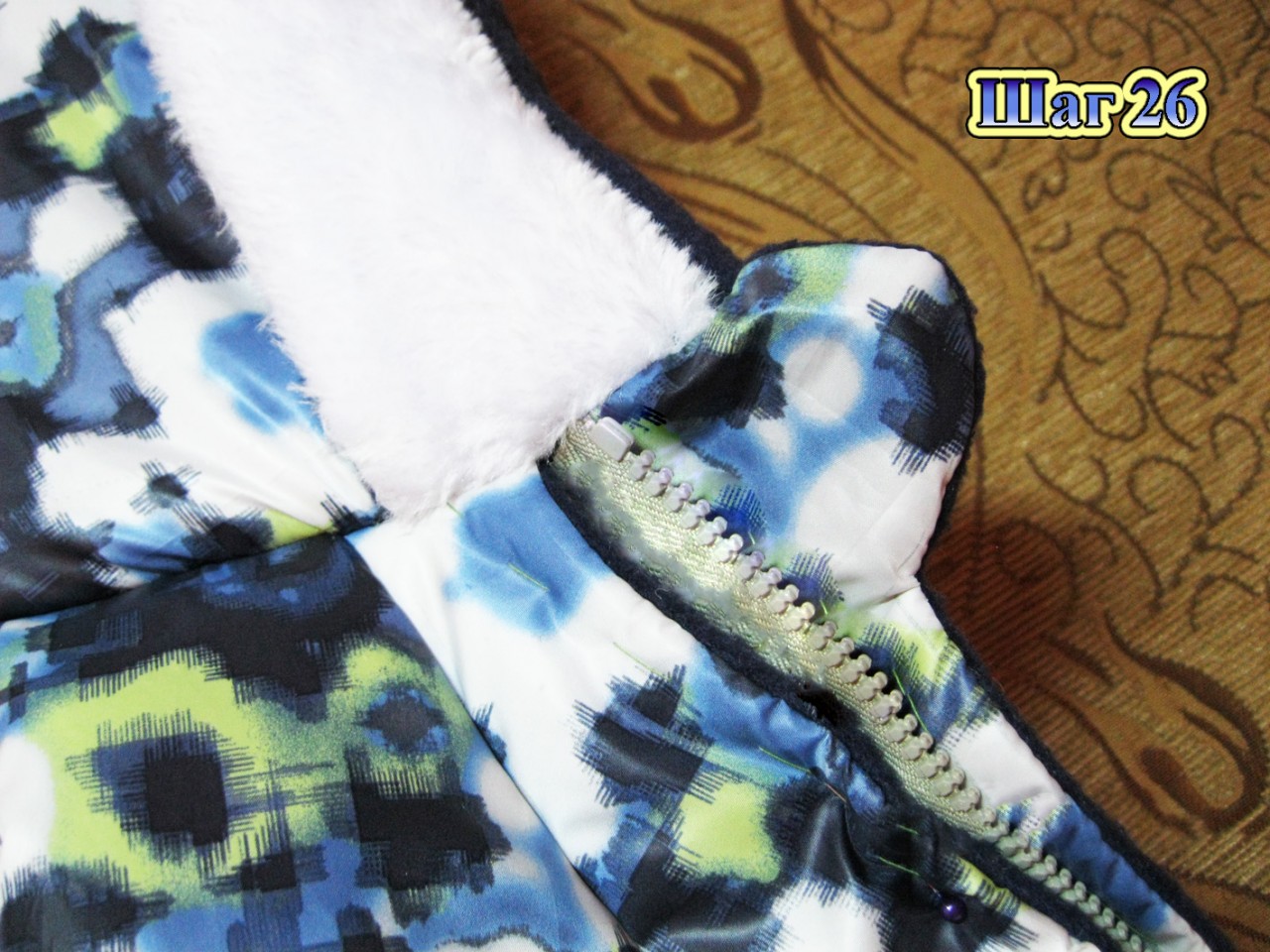
Step 27 Let's start sewing down the details of the lining of the overalls. I did not baste the fleece parts along the edges, since the fleece does not slip on the padding polyester.
The grinding algorithm is similar:
- 1. Connect the front sides and the central front part.
- 2. We cover the cuts for the zipper.
- 3. Sew the back pieces along the middle seam. There is no need to sharpen the elastic!
- 4. We connect the front and back parts of the lining along the middle seam between the legs. There is no need to sew the side seams yet, they will be sewn together with the sleeve!
- 5. Sew the sleeves to the front and back parts of the lining. Fold the lining and sew the sleeve seam and the side seam of the lining (in one seam).
This is what happens at this step:
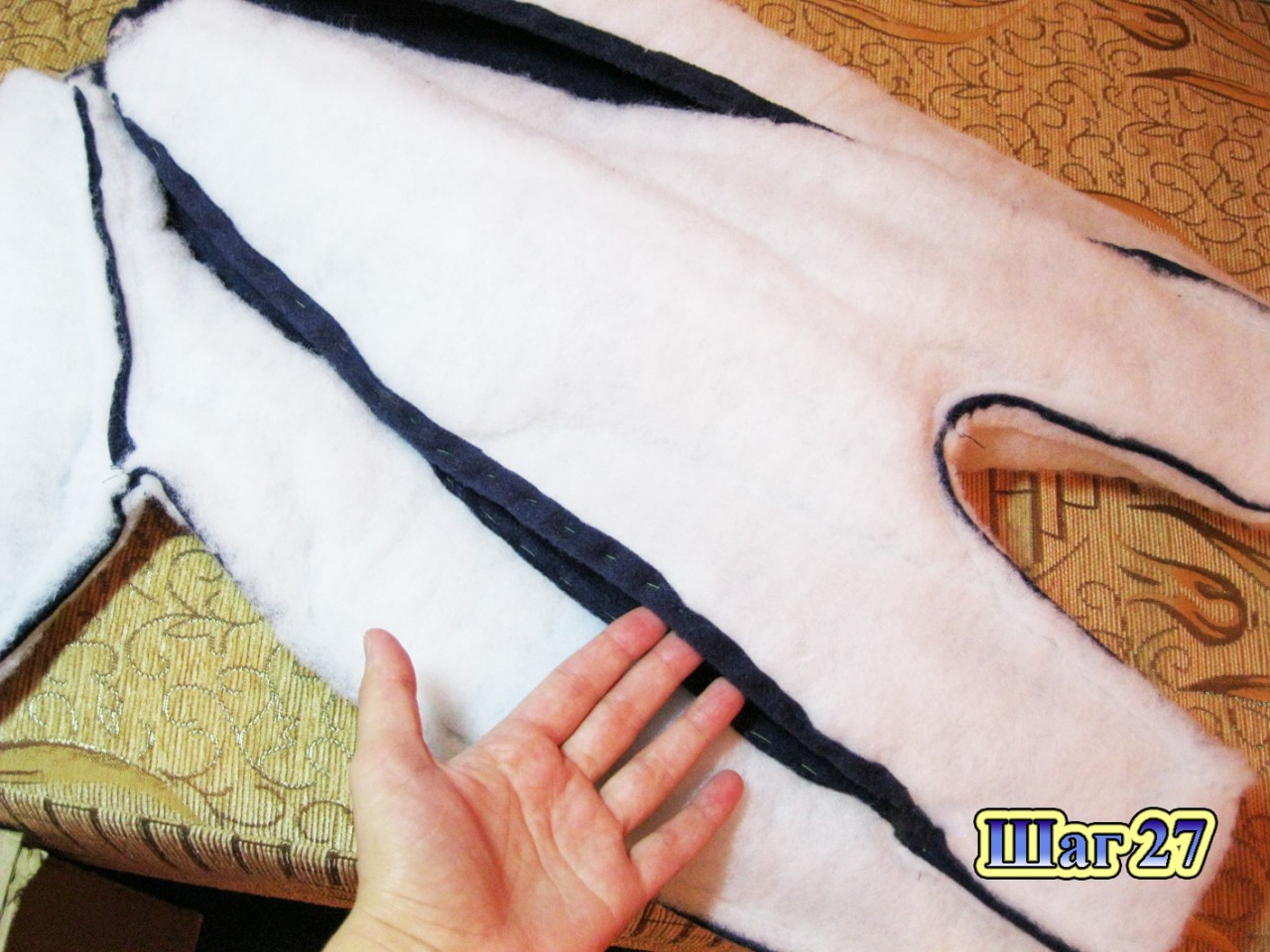
Step 28 I made drawstrings for elastic on the sleeves and legs. To do this, you need to cut out strips from the main fabric, the width of the strip is 4-5 cm, to determine the length, measure the length of the cut of the sleeve and trouser leg with a centimeter tape and add an increase for the seam (I hope I expressed myself clearly, maybe it will be clearer in the photo). We sew it on the sides so that there are neat edges at the drawstring.
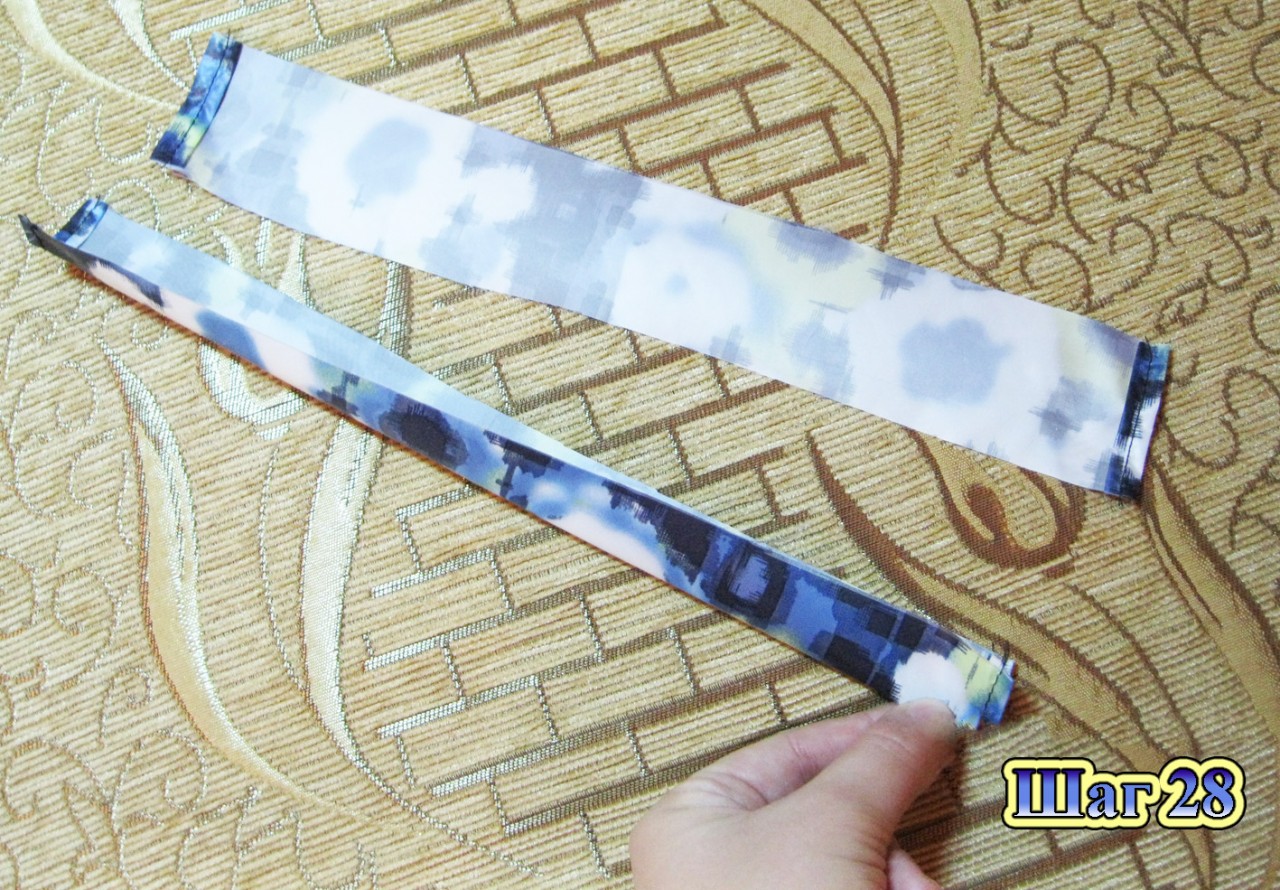
Step 29 We attach the drawstrings to the sleeves and trouser legs.
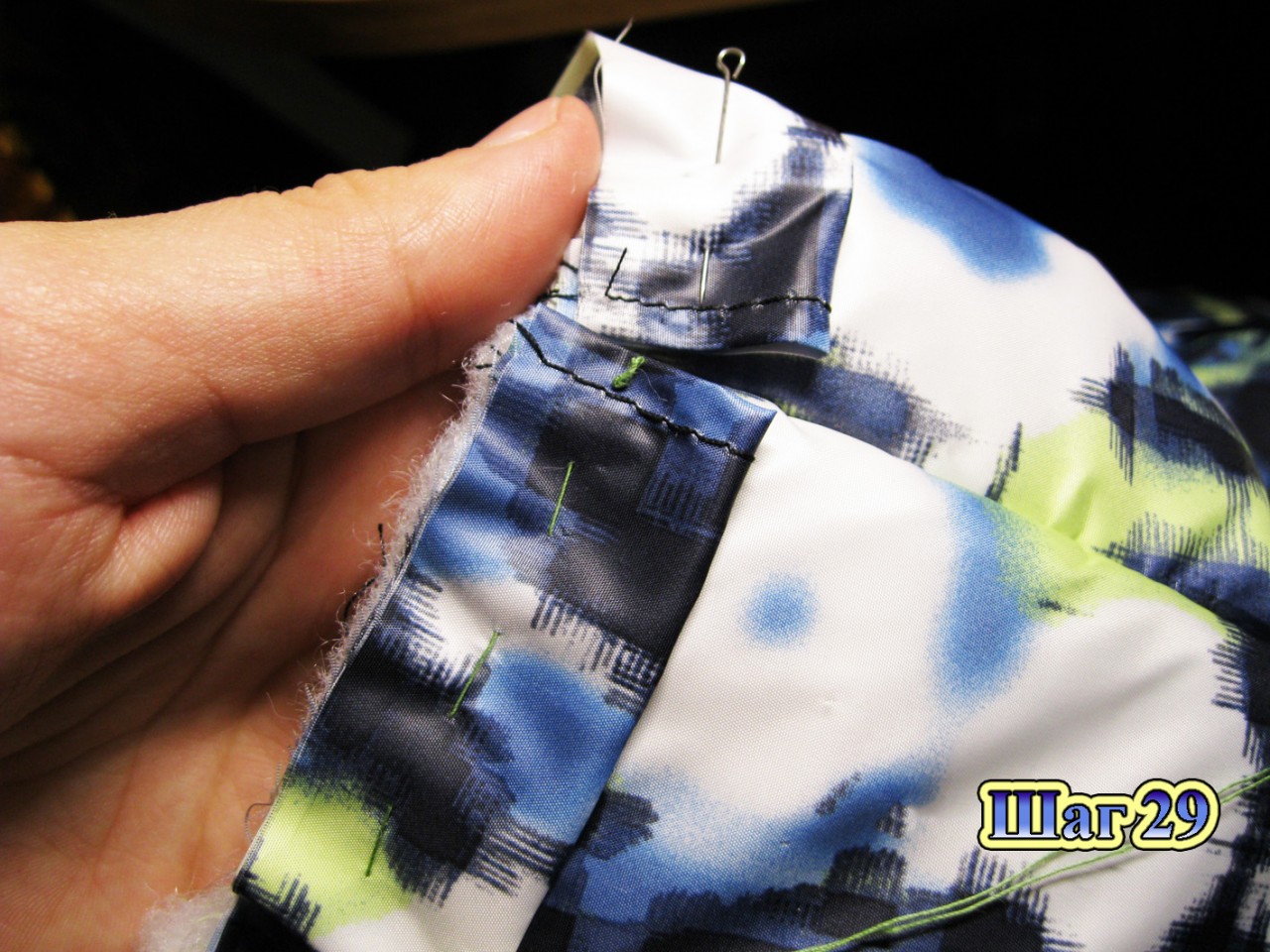
Step 30. We sew down the side parts of the boots, baste them to the legs of the overalls and attach them.

Step 31 We baste and attach the trace.
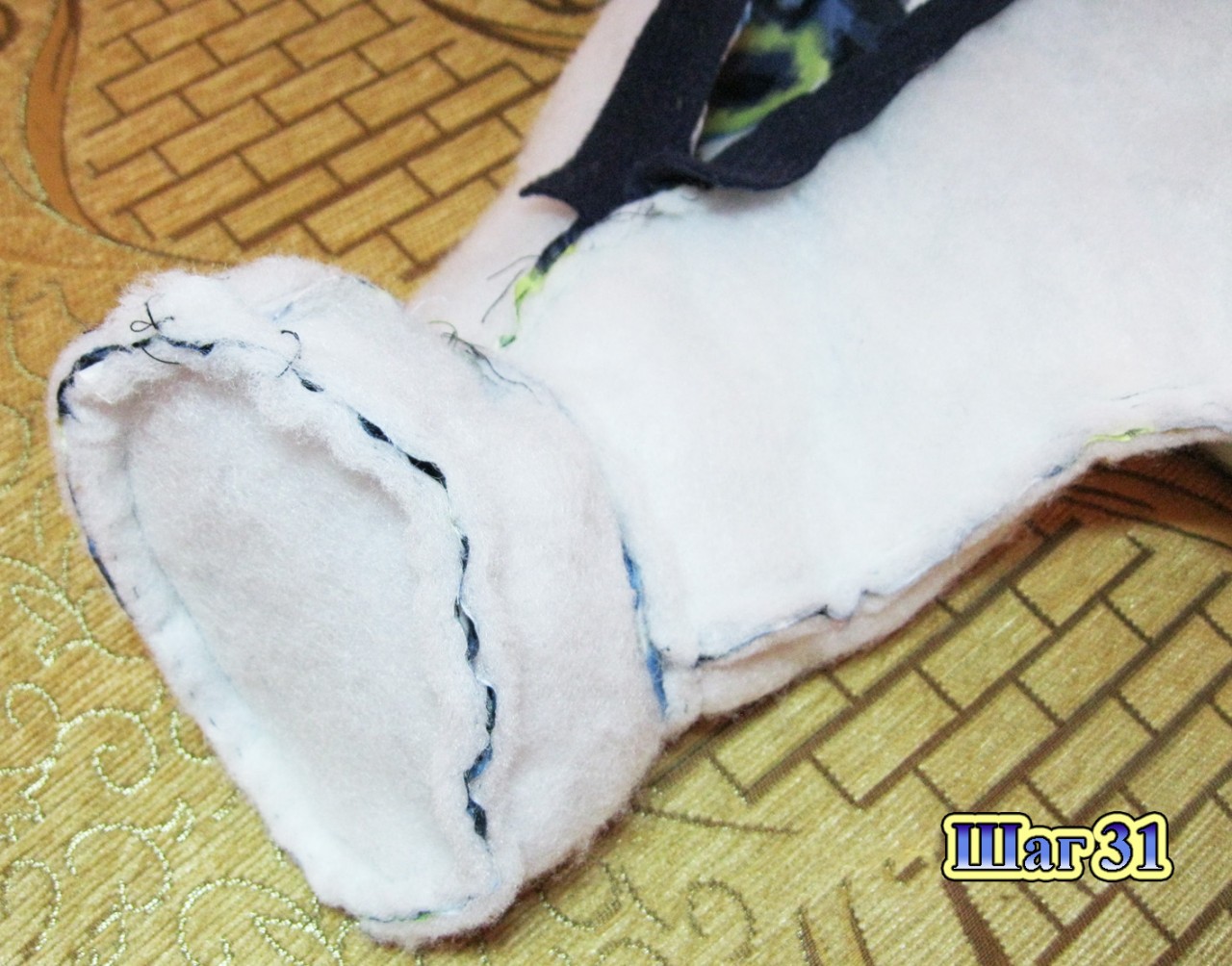
Step 32
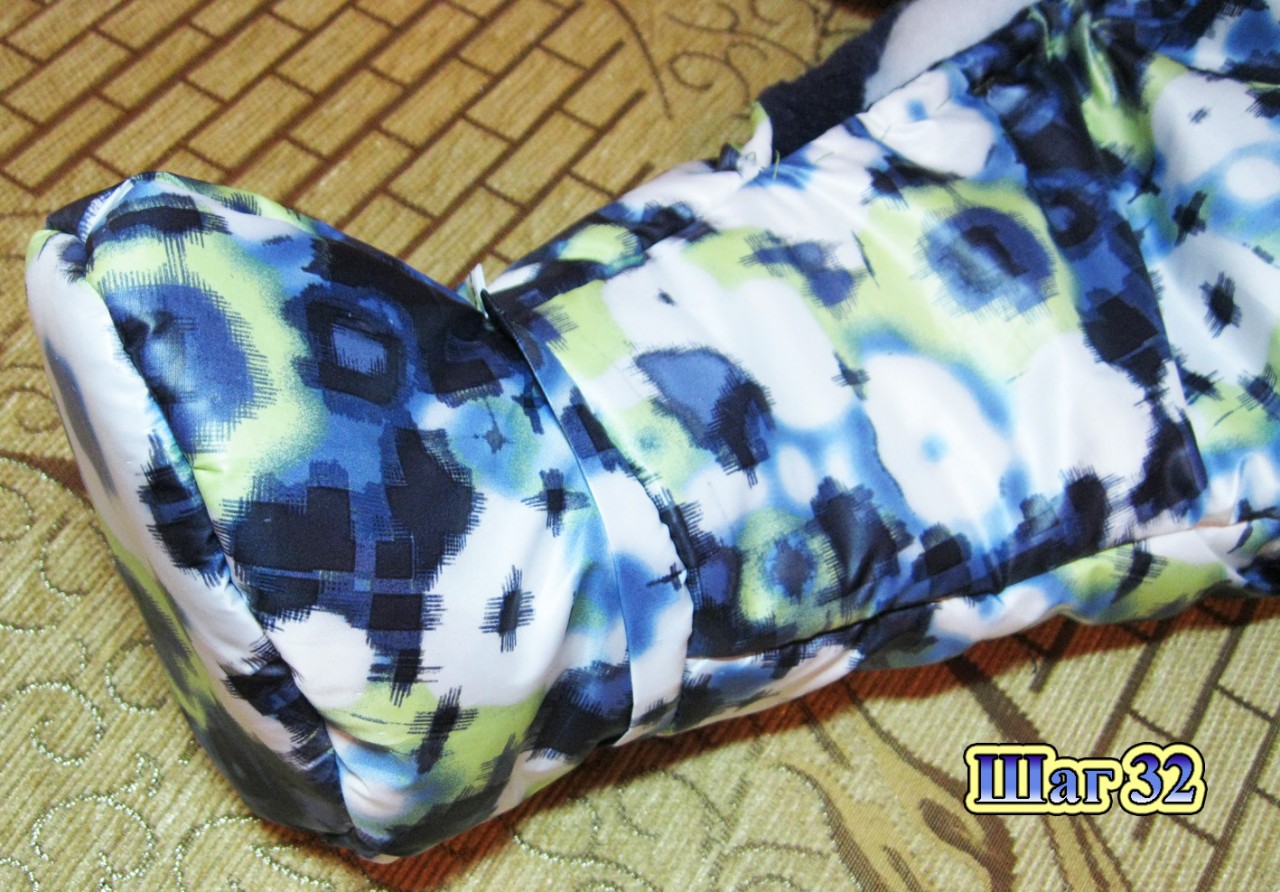
Step 33 We wash and grind off the mittens.
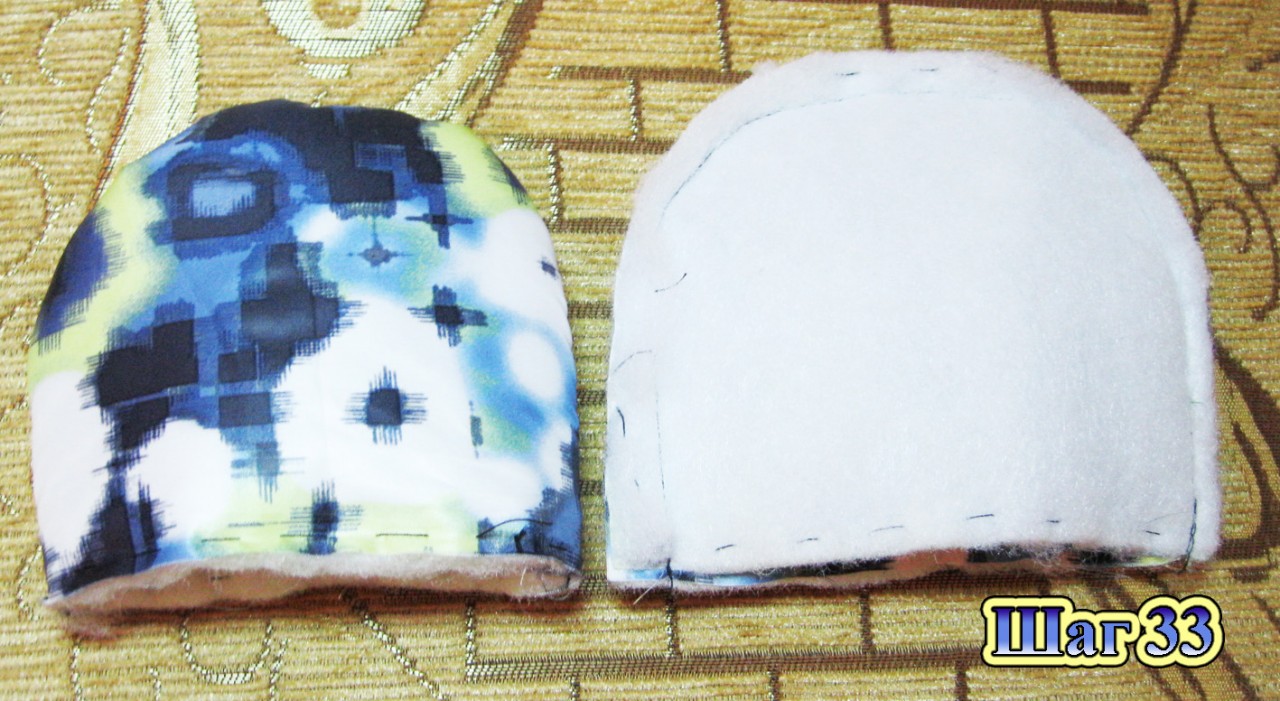
Step 34 We insert the mitten into the sleeve, baste and stitch.
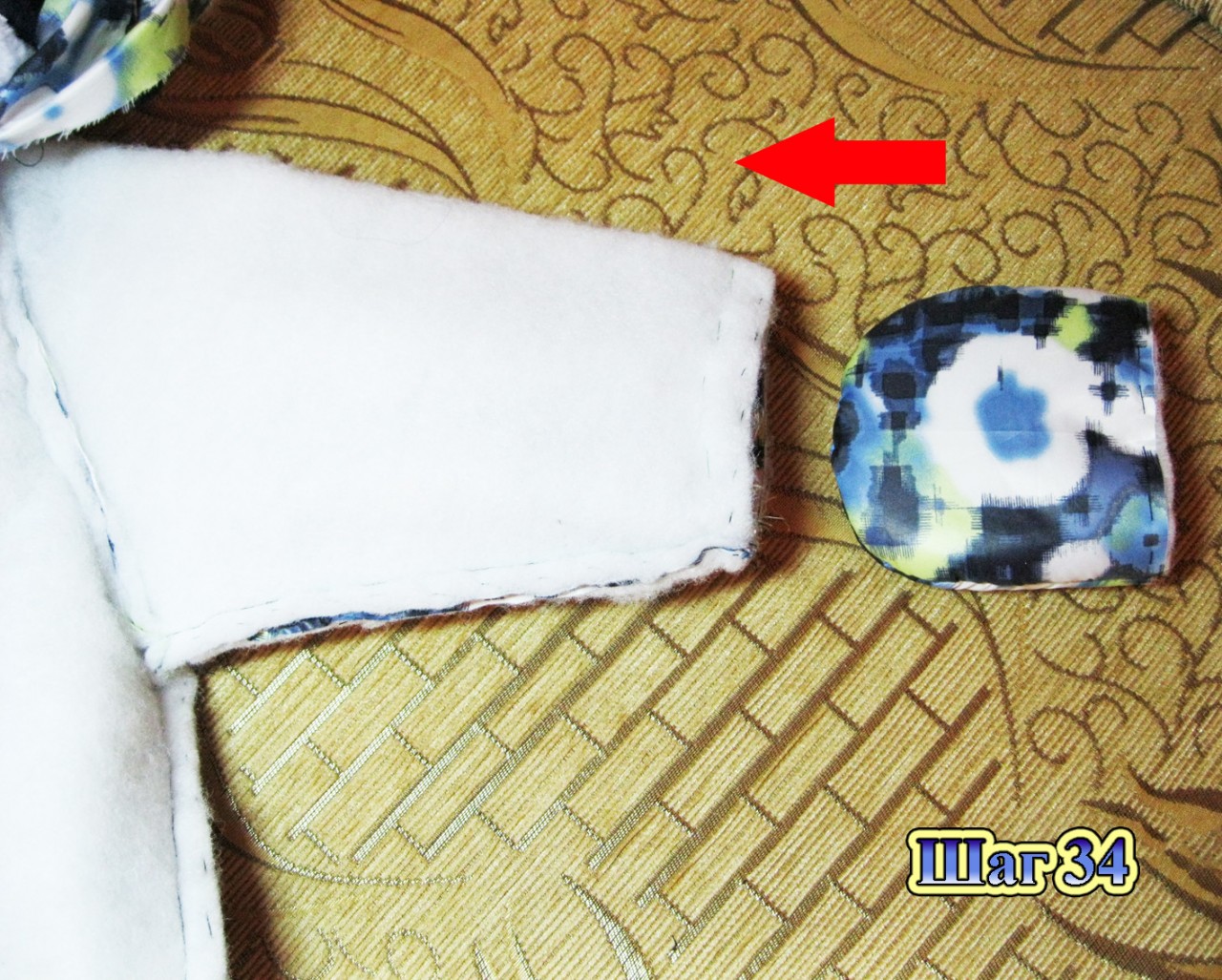
Step 35. Turn it inside out. Here's what we got:
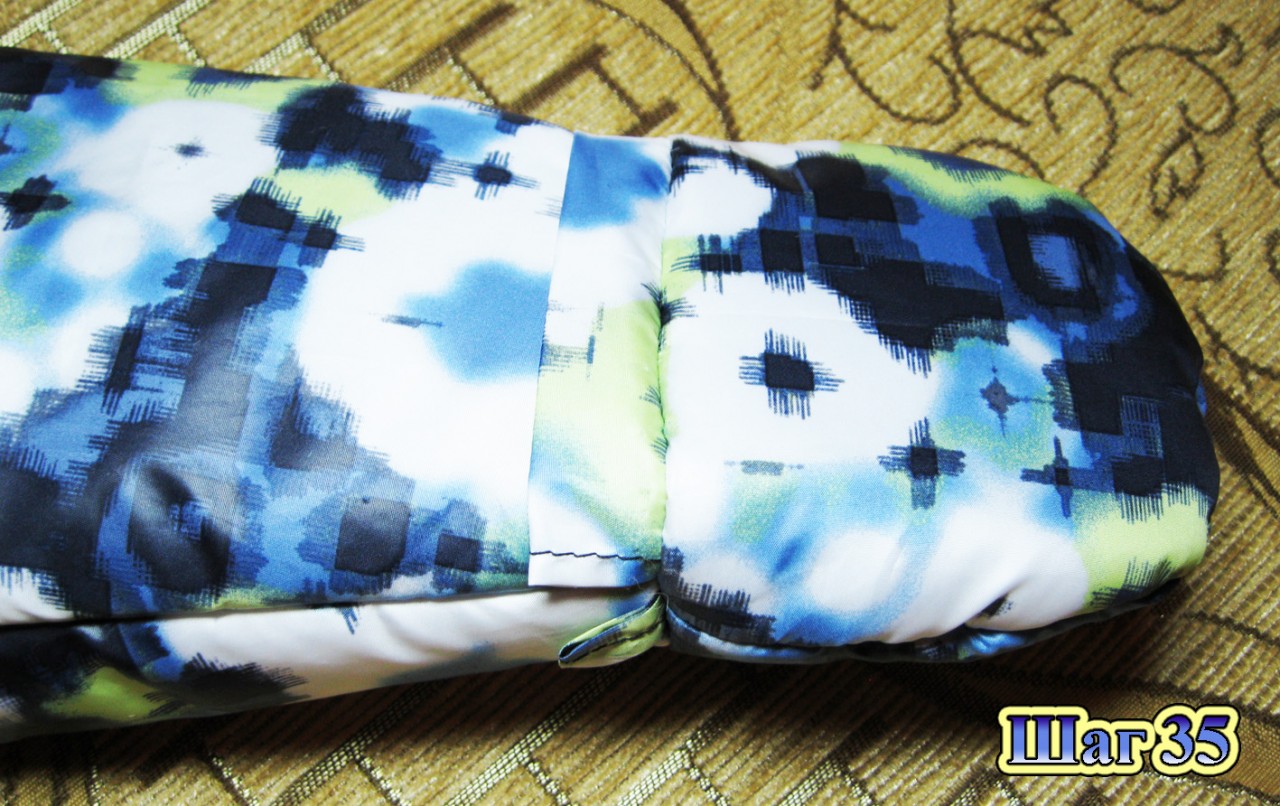
Repeat steps 30-35 for lining the overalls
Step 36 At this step the overalls look like this:
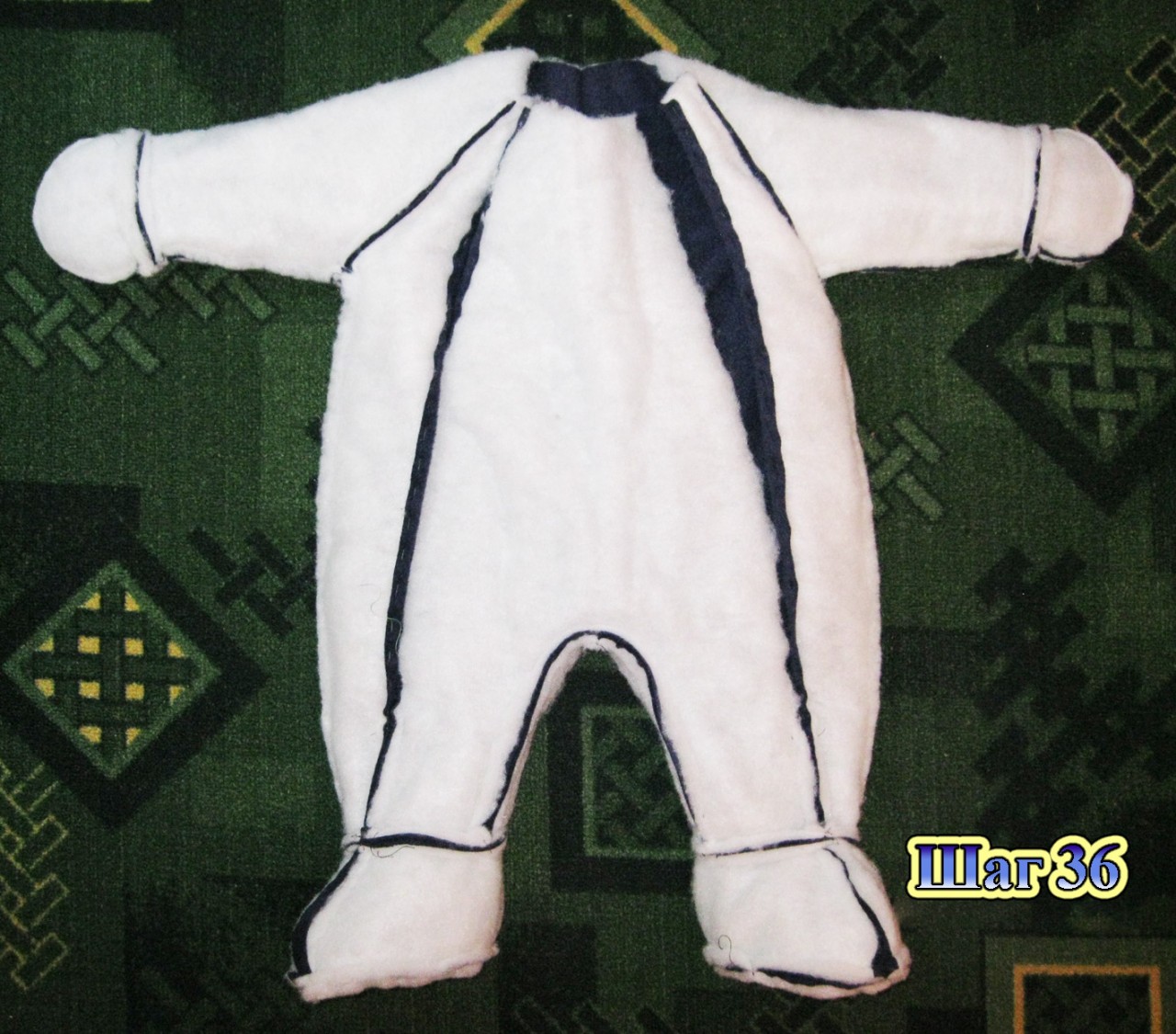
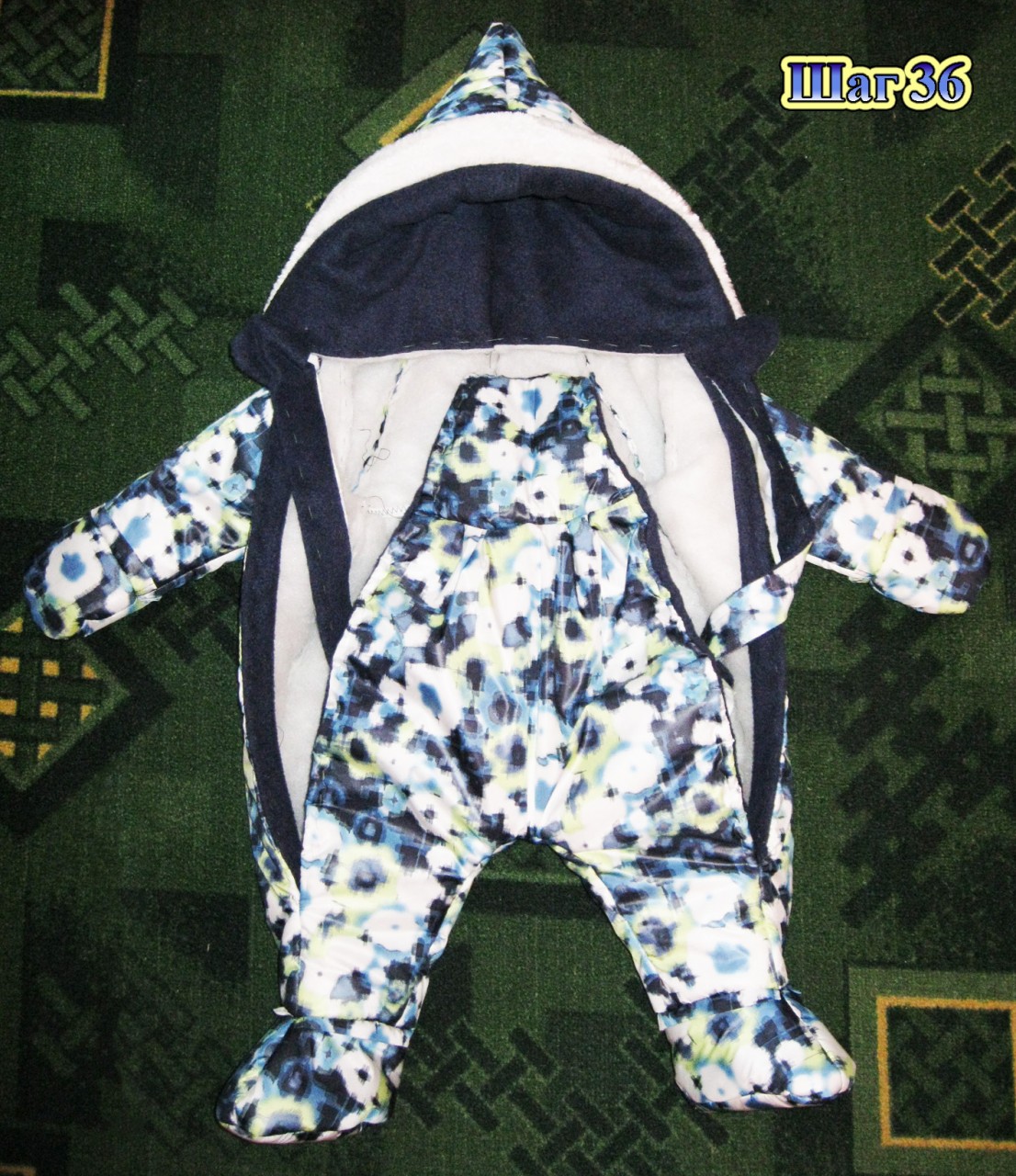
Step 37 We combine the front side of the overalls lining and the front side of the hood lining, baste them and sew them (in the photo the seam is indicated by a red dotted line).
![]()
Here's what happened:

Step 38 We connect the front side of the main fabric yoke with the front side of the lining yoke, baste and stitch.

Turn it inside out. Here's what happened:
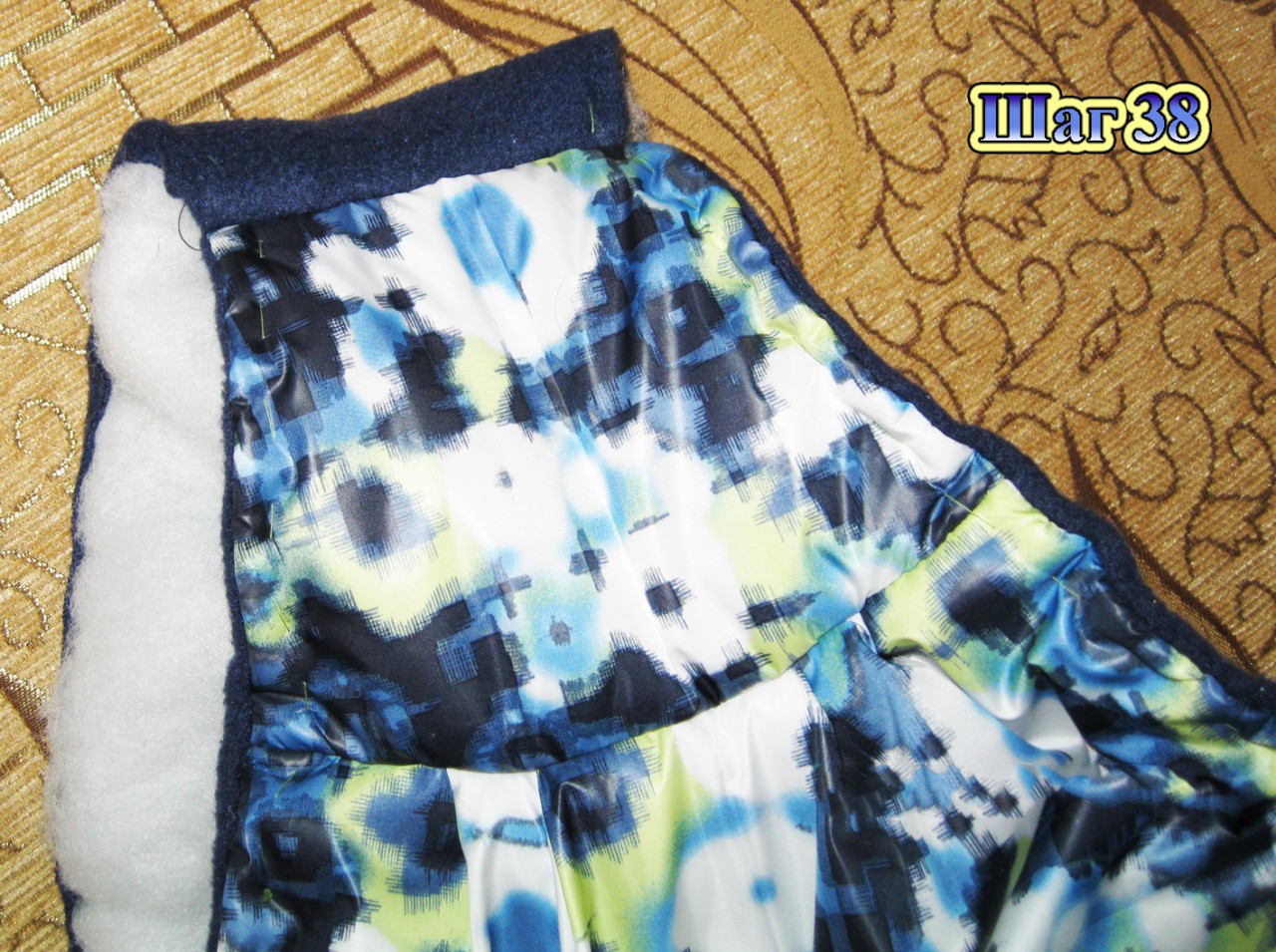
Step 39 We insert the lining into the overalls. We make stitches by hand in several places, thereby connecting the overalls from the main fabric and the lining (the stitches should be free). This is necessary so that the lining does not get lost. You definitely need to connect the boots and mittens, the rest is at your discretion, but it is better to connect them in several more places, so the lining will be securely fixed in the overalls.
![]()

Step 40. We insert the zipper into the slit and baste it to the front side of the overalls (don’t touch the lining yet). It is advisable that the zipper teeth be covered with fabric.


Step 41 Attaching the zipper. My fabric shifted a little during stitching, so the zipper teeth were not completely covered by the fabric, although I intended to close them completely. But it’s okay, the backing for the zipper will save us in this case, it is quite wide, inserted from the inside, so it will block the zipper and press against it.
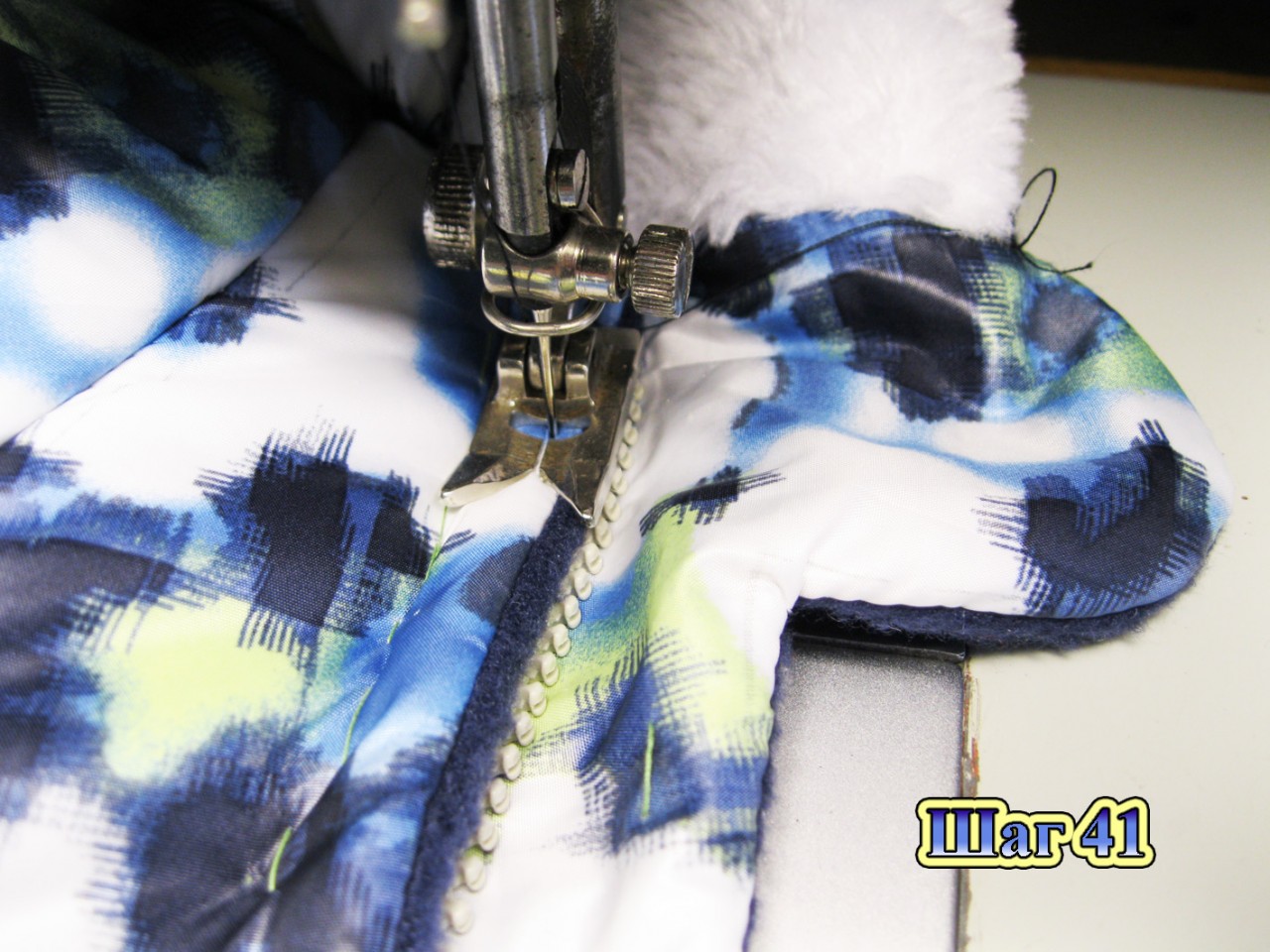
Step 42 We baste the lining to the zipper from the wrong side of the overalls (on one side we baste it to the backing for the zipper, on the other side to the zipper itself)
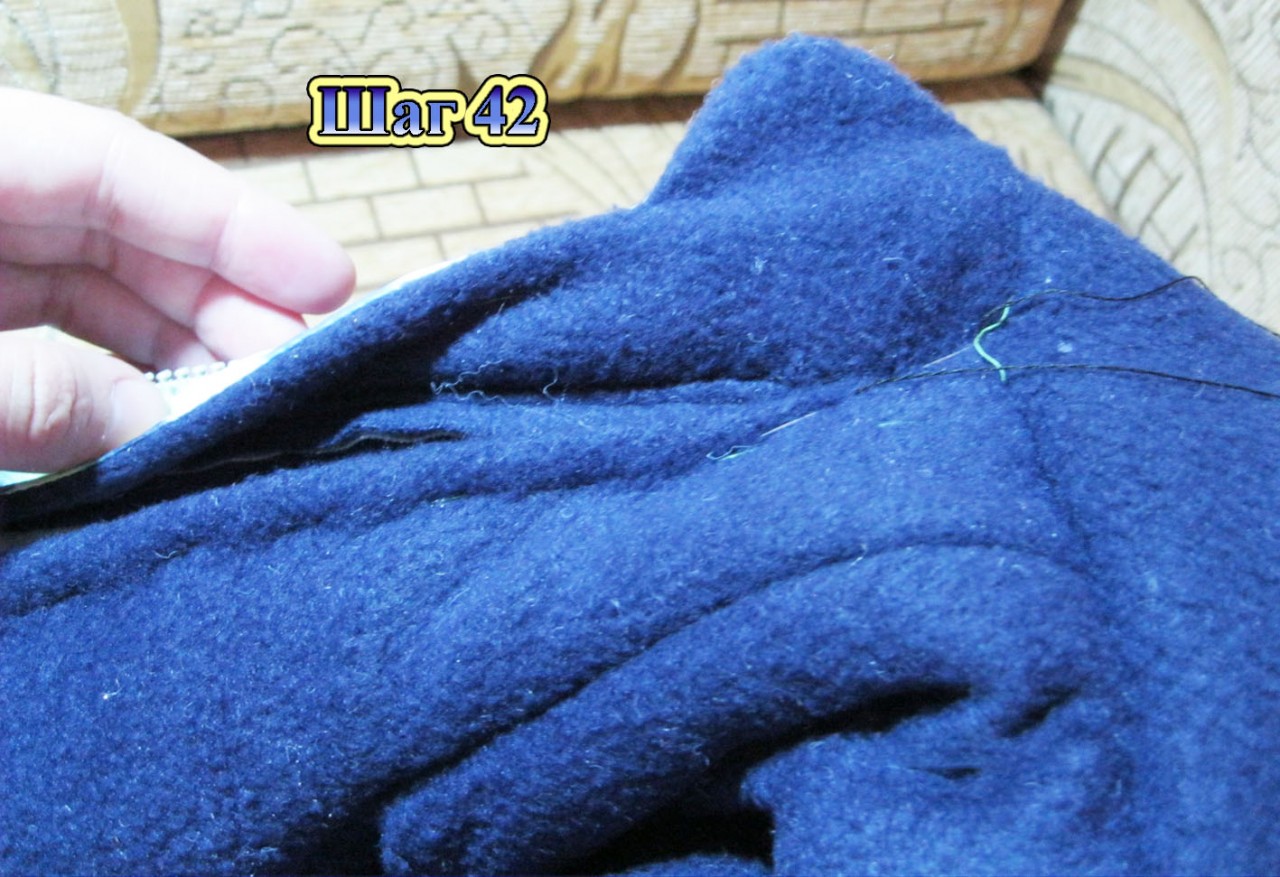
Step 43 We trim the seam of the backing for the zipper and stuff it with padding polyester, but not too tightly. Then we sew this place with hidden stitches.
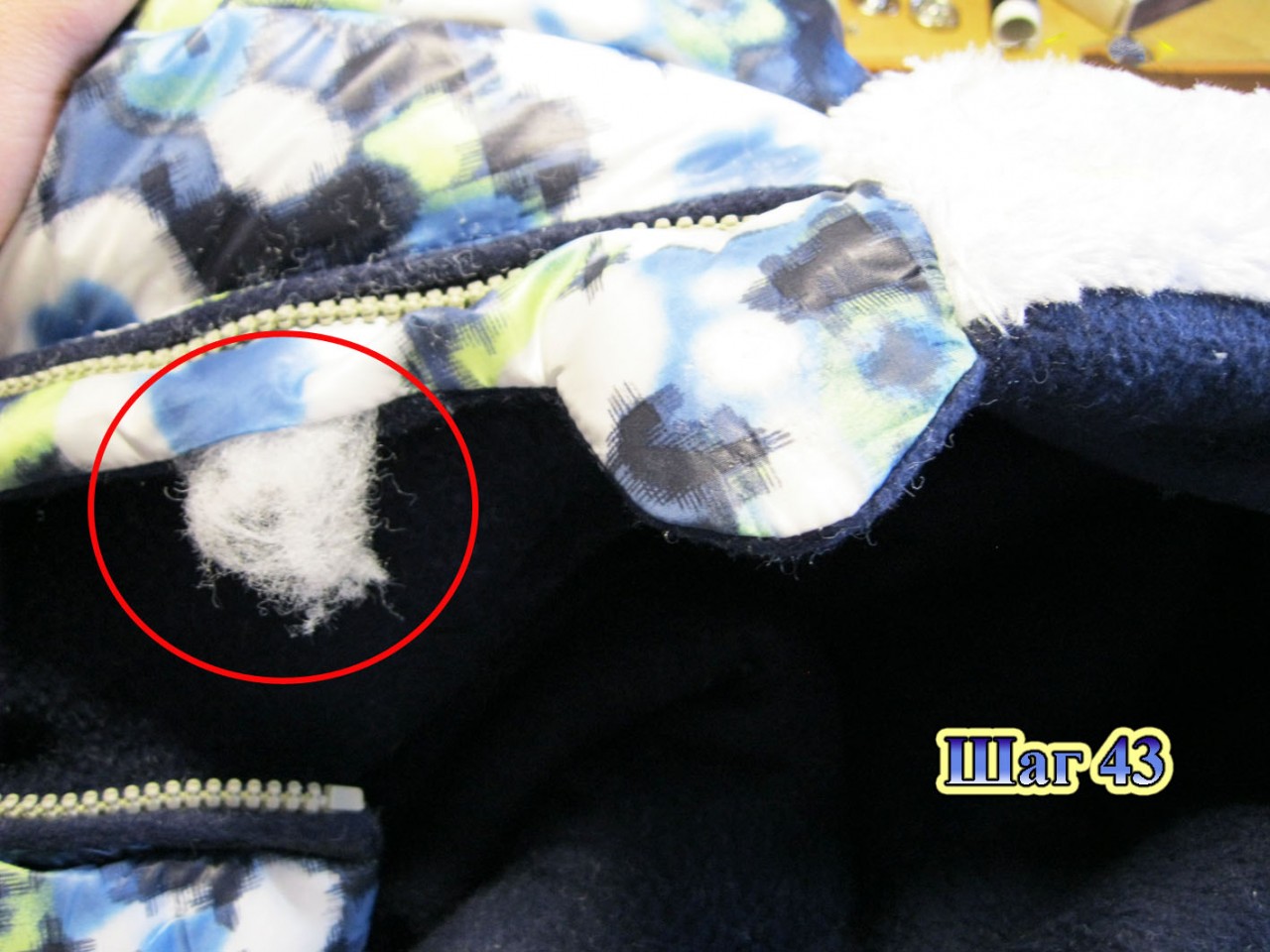
44. We insert the lace into the drawstring of the hood and sew the button to the backing for the zipper.

Attention! Make sure that when the backings for the zipper are fastened to the button and the zippers on the overalls are fastened, the yoke should fit snugly against the backings, otherwise there will be a free space and heat will escape from the overalls.
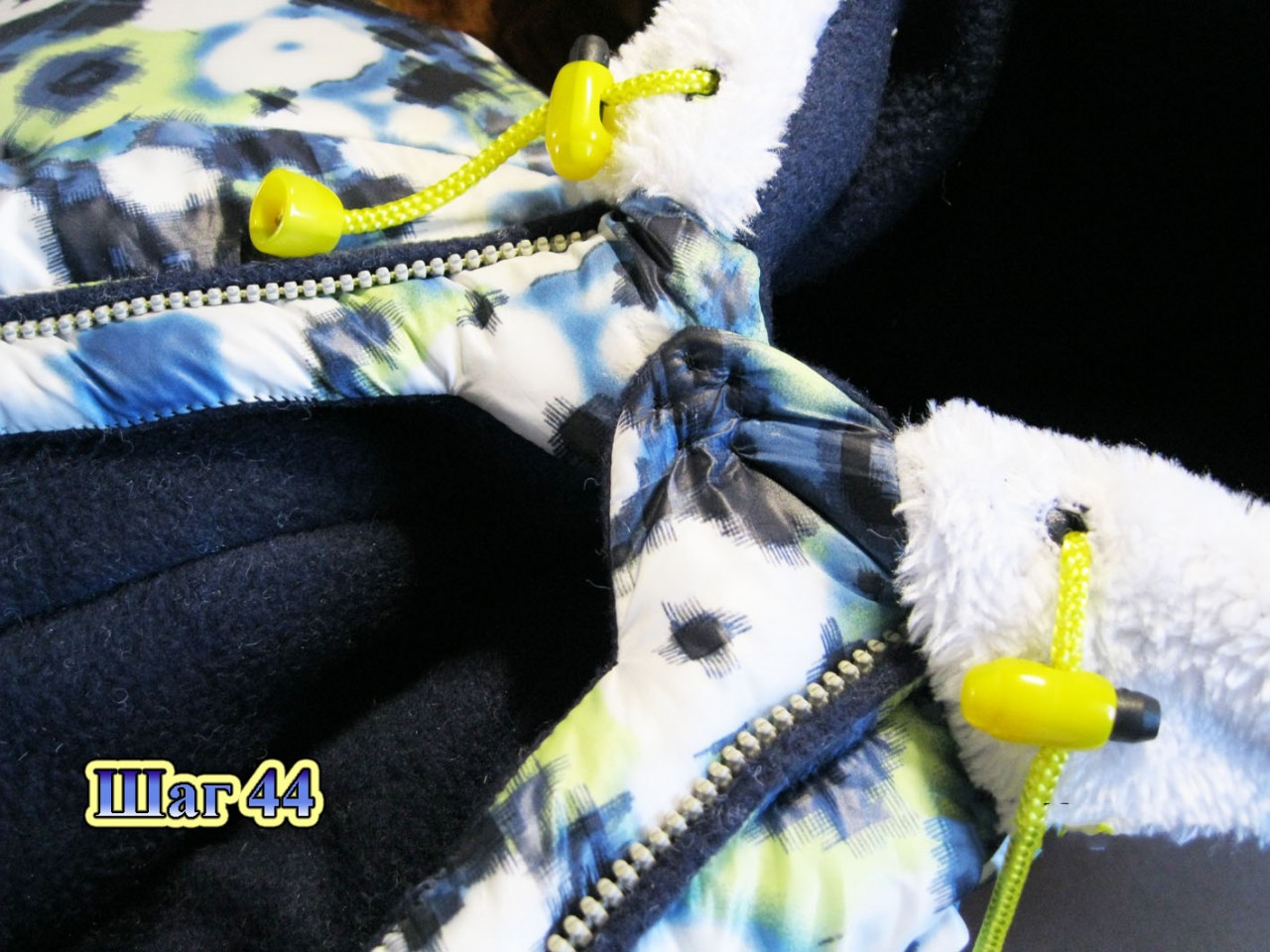
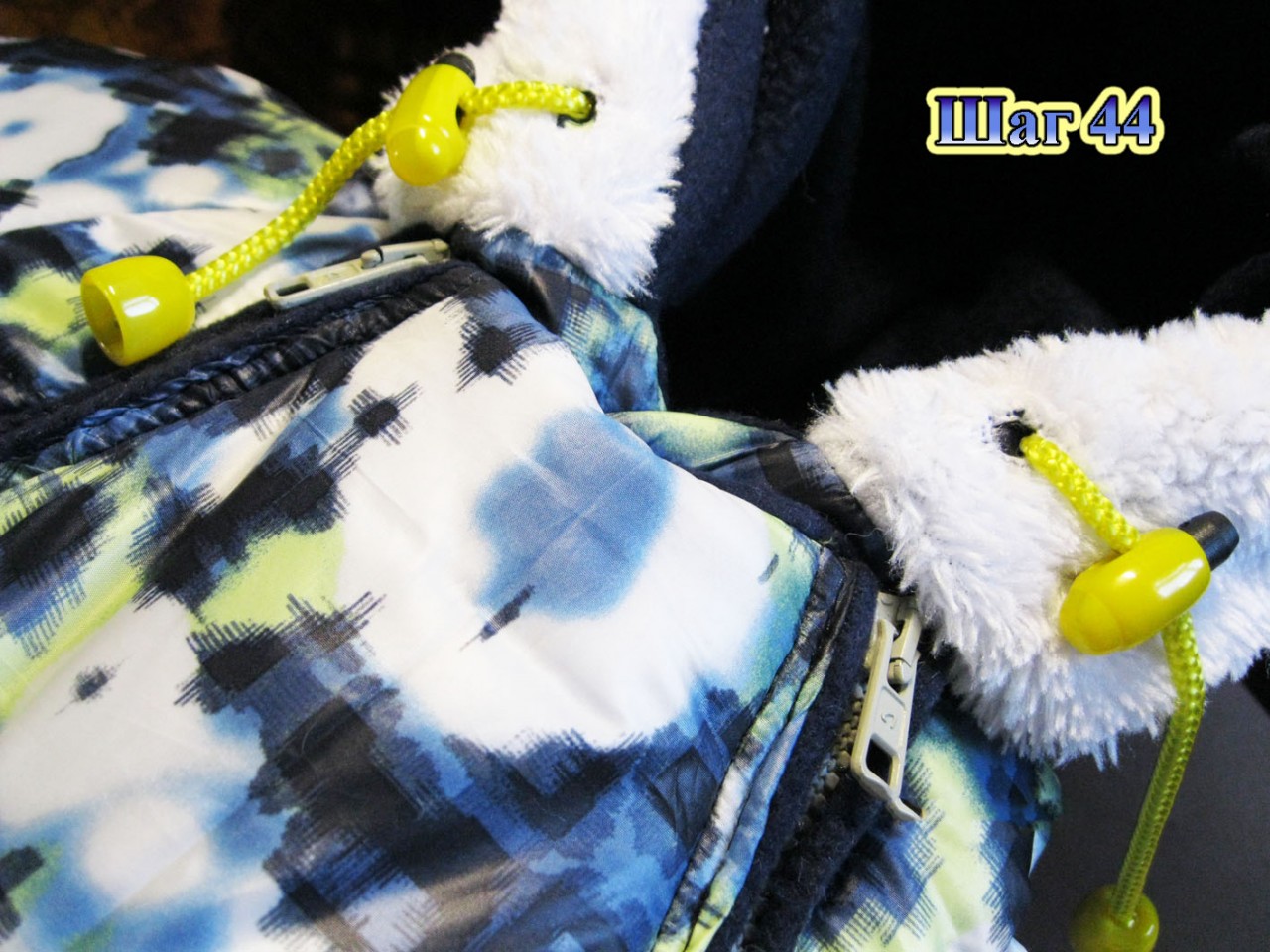
Step 45. We insert elastic bands into the drawstrings on the sleeves and legs (you can insert laces as you like). They play more of a decorative function.

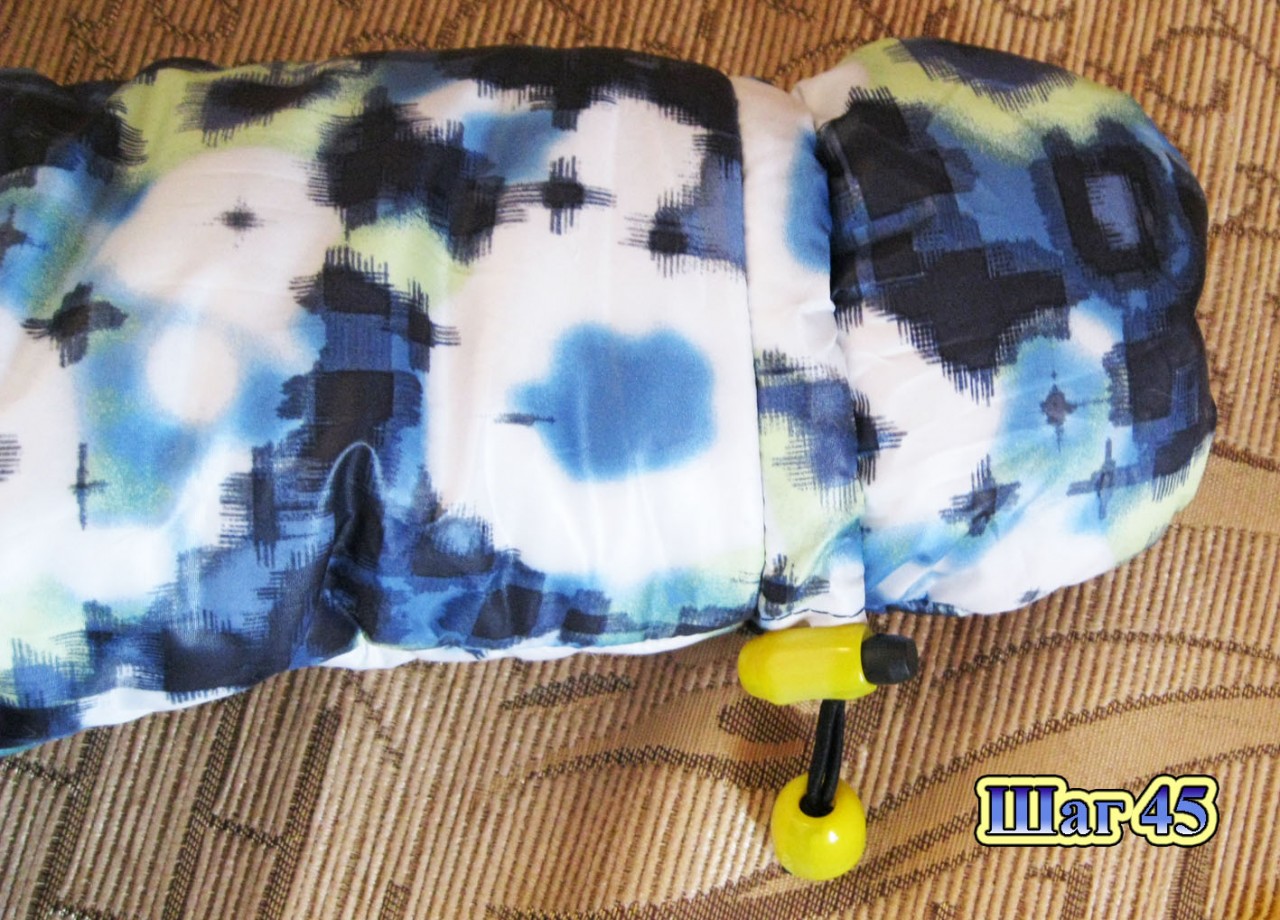
The jumpsuit is ready!

Daughter in new overalls!

Children's clothing should be comfortable and bright, especially in summer! This jumpsuit with the cute, mischievous face of cartoon Mickey Mouse will definitely please your child and become his favorite. This model with a straight skirt is very comfortable and practical. And it has all the attributes of a real grown-up denim item - pockets with hemmed barrels, a stitched waistband, double stitching, an imitation codpiece, belt loops and long straps that cross along the back and end with naughty paws.
Let's start modeling the overalls by creating a pattern for a straight skirt. Actually, this is the main basic pattern that is necessary for modeling. The basic skirt pattern is very simple to construct. Use your child's measurements or standard measurements from the measurement table to create a straight skirt pattern.
As we said above, the jumpsuit is based on the skirt pattern. It will not be difficult for you to build it and will not take much time. It will be more convenient for you to create a pattern on graph paper. After construction, transfer the front and back halves of the skirt separately onto tracing paper for further modeling.
Constructing a straight skirt pattern for a girl
To create a pattern, we use standard measurements:
Height 122 cm
Waist circumference 56 cm (1/2 OT = 28 cm)
Hip circumference 67 cm (1/2 OB = 33.5 cm)
Hip height 14 cm
Skirt length according to measurement 30 cm
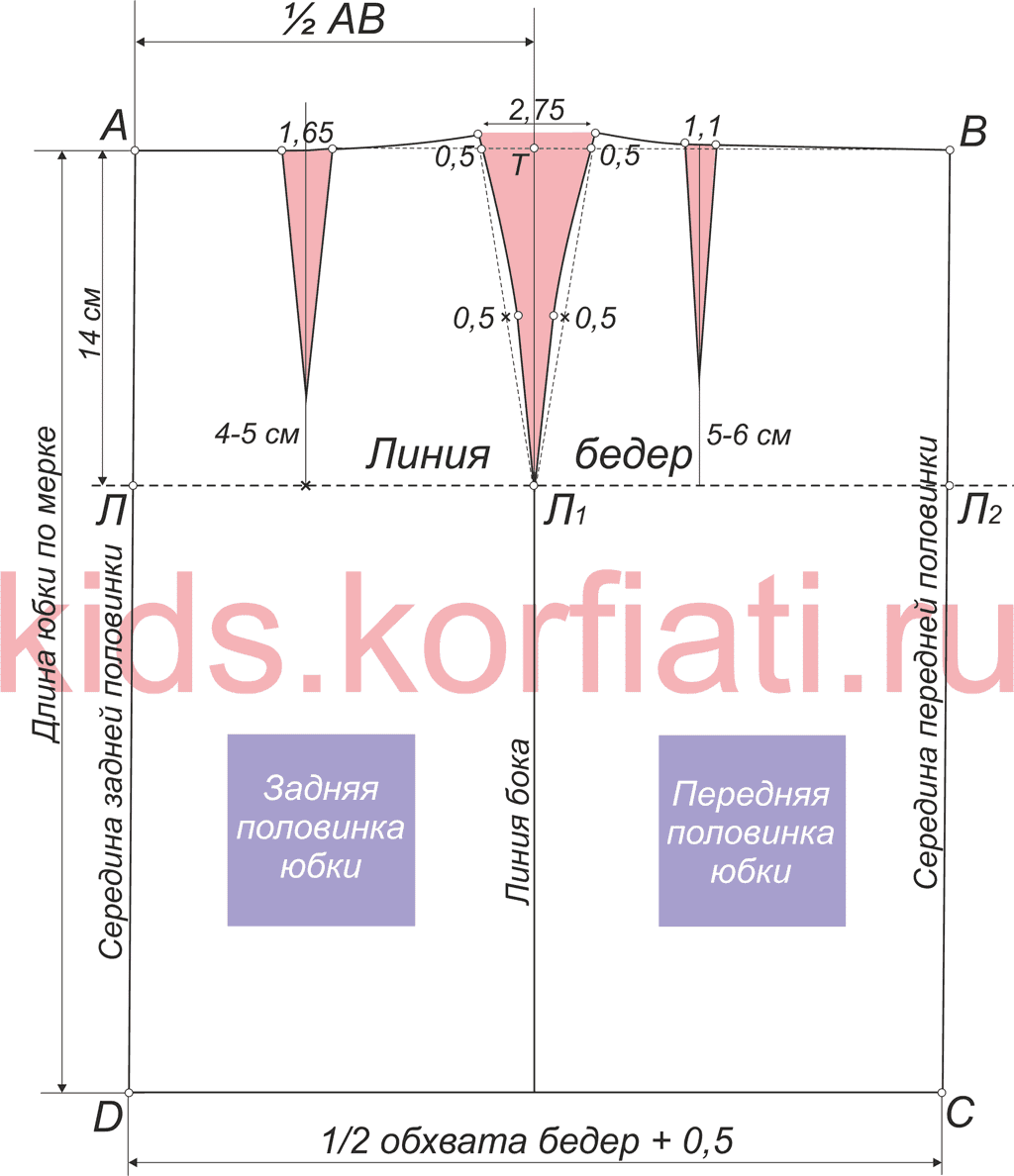
Rice. 1. Pattern of a straight skirt for a girl
Draw rectangle ABCD.
Skirt width. The lines of the rectangle AB and DC are equal to 34 cm (half the circumference of the hips as measured plus 0.5-1 cm for all sizes): 33.5 + 0.5 = 34 cm.
Skirt length. The lines of the rectangle AD and BC are equal to the length of the skirt as measured. In the model presented above, the length of the skirt for a height of 122 cm is about 30 cm.
Side line. From point A to the right, set aside 1/2 of the segment AB and place point T.
From point T, lower the perpendicular down until it intersects with the DC line.
Hip line. From points A, T, B, set down 14 cm (hip height according to measurement), put points L, L1 and L2 and connect them with a dotted line.
Calculation of the depth of darts at the waist line. At this stage, you and I must determine the difference between the half-hip circumference according to the measurement and the half-waist girth according to the measurement: 33.5 - 28 = 5.5 cm.
The difference is 5.5 cm. In the side dart we remove 0.5 of the difference, that is, 5.5 * 0.5 = 2.75 cm, in the front dart we remove 0.2 of the difference: 5.5 * 0.2 = 1, 1 cm and remove 0.3 differences into the back dart: 5.5*0.3=1.65 cm.
IMPORTANT! At this stage, for a more accurate distribution of darts, we recommend assessing the child’s figure. If there is a small tummy, it is better not to make a front dart, but to transfer all the excess volume to the back dart.
Side dart of the skirt. The side dart is 2.75 cm. From point T to the right and left, set aside 1.4 cm (half the depth of the side dart): 2.75/2 = 1.4 cm.
Lift up lateral lines up 0.5 cm and make them slightly curved. To do this, connect the dots 0.5 dotted lines with point L1, divide them in half and set aside 0.5 cm from the dividing points left to right and right to left. Draw smooth lines for the sides.
Front dart of the skirt. The depth of the front dart is 1.1 cm. From the side line to the right, 1/3 of the length of the waist line of the front half, draw a perpendicular down, the length of the front dart should not reach the hip line by 5-6 cm. From the point of intersection of the perpendicular with the waist line to the right and set aside 0.55 cm to the left.
Back dart. The depth of the back dart is 1.65 cm, the length of the dart should not reach the hip line by 4-5 cm. Divide the AT in half and set aside 0.85 cm from the division point to the left and right.
Waistline of the back and front halves. Draw the waist lines of the back and front halves slightly concave smooth lines, connecting points 0.5 with points A and B.
After completing the pattern of a straight skirt for a girl, proceed to modeling the overalls.
Modeling overalls for girls
Before you start modeling the jumpsuit, pay attention to the design features of the model: an elastic band is inserted into the waistband of the skirt along the back, so when constructing basic pattern Do not make a dart on the front half of the skirt, but add all the excess to the dart on the back half of the skirt.
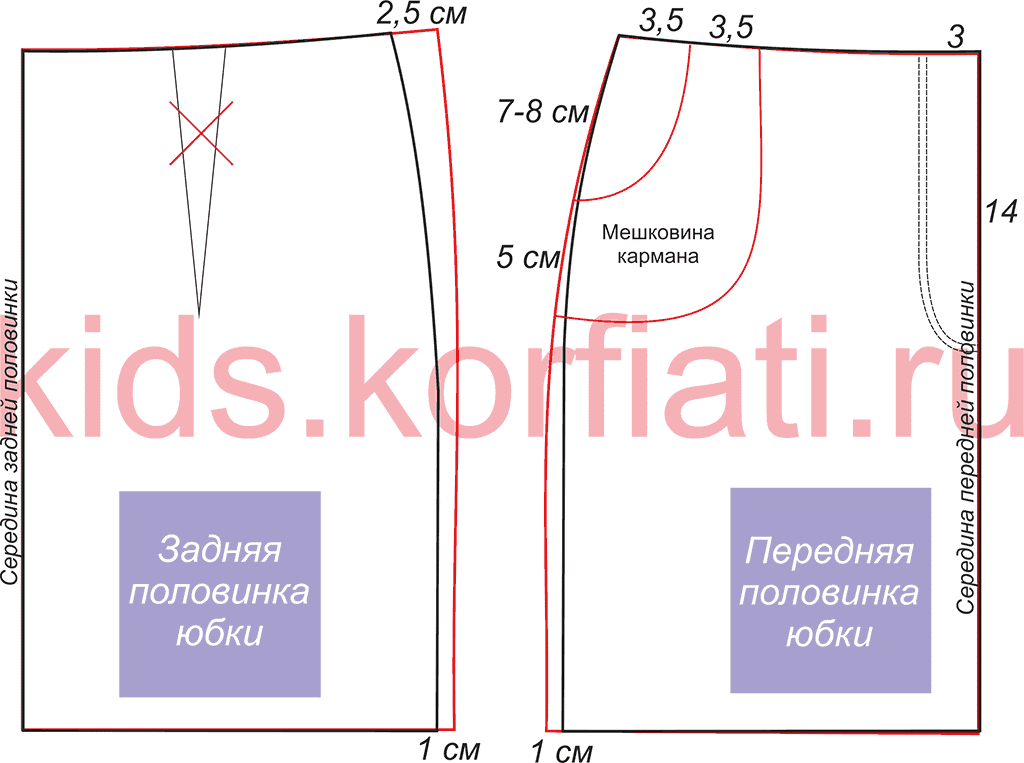
Rice. 2. Modeling a jumpsuit for a girl
On the side of the back half of the skirt, make an increase: at the bottom - 1 cm, at the top - 2.5 cm. Draw new line sides Remove the tackle dart.
On the front half along the bottom, set aside 1 cm to the left and draw a new side line. Model the pocket entrance and pocket burlap. Along the middle seam of the front half, mark a stitching 3 cm wide and about 14 cm long.
Modeling the top, belt and straps of overalls
To model the top, use the front of the skirt. Measure the length of the waist section of the back half of the trousers and draw a detail of the front waistband and back waistband (length according to the measurement of the waist section according to the pattern).
From the front waistline, lift up a short perpendicular. Set aside 2 cm to the right and draw a rectangle ( top part overalls) 25 cm high. From the upper corner of the rectangle, set aside 4.5 cm to the right (you can increase this value to 6 cm if necessary). Connect points 2 and 4.5 with a slightly curved smooth line.
Measure the length of the straps, taking into account that they will be crossed along the back and extended.
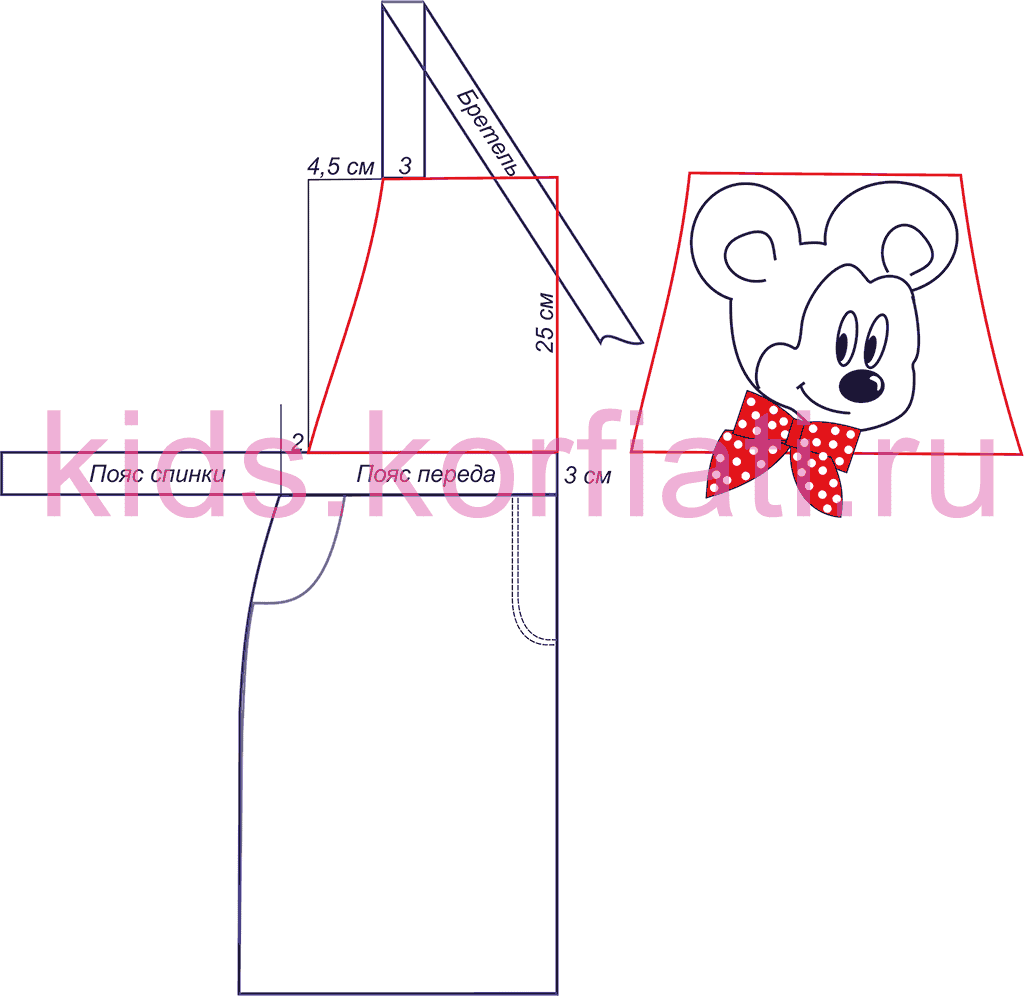
Rice. 3. Modeling the top, belt and straps of the jumpsuit
Transfer the detail of the belt, top, barrel, burlap pocket and straps onto tracing paper and cut out separately. You can buy a Mickey Mouse applique ready-made or make it yourself. We will tell you how to do this a little later.
Almost every baby has a onesie in their wardrobe. It is comfortable to put on and wear. It does not restrict movement. They are sewn from lightweight fabrics and quilted with almost weightless fillings. Last factor makes such clothes more comfortable to wear in autumn-spring and winter time compared to heavy sheepskin coats. The pattern of a children's overalls with a hood will allow you to sew it at home.
Winter coveralls
Let's look at children's patterns winter overalls.
This option can be taken as a basis, adjusted to the desired size, or sewn for a height of 110 cm and a chest circumference of 56 cm. This pattern provides:
- Hood. It can be made detachable or sewn in.
- The fastener is used in the form of a zipper.
- A stand-up collar made from fleece, fur or other materials.
- Belt with clasp.
Working with the pattern:
- Redraw or print the drawing.
- Be sure to check compliance taken measurements pattern.
- The jumpsuit can be decorated with finishing trim, as indicated on the pattern, or you can come up with your own version of the decoration.
- The drawing does not include seam allowances.
- Cut the lining and insulation according to the main pattern.
This option is suitable for girls and boys.
Watch videos on sewing winter overalls below:
Here are more patterns:


Large selection of patterns different sizes presented in Burda magazines.
Pattern for babies in the first months of life
Let's continue the topic winter clothes. Below is a pattern for a baby jumpsuit for a newborn.
Selecting fabric
It is better to choose a material that is durable, waterproof and breathable at the same time. Such fabrics are made on the basis of polyamide.
Beginning of work
Transfer the pattern to the fabric, being sure to take into account the seam allowances.
- on the sides and shoulders - 2 cm;
- for the neckline, armholes and double elements - 7 mm each;
- on the front - 3 cm;
- For processing seams, leave 1.5 cm.
Sequence of actions
- First, the pockets are sewn on, then the front piece is connected to the side pieces.
- Preparing the collar, sewing the seams on the shoulders.
- Baste the collar to the neckline and finish the fastener.
- At the waist, sew the fabric in the form of a strip in order to insert an elastic band.
- Sew on the sleeves.
- Sew on the bottom.
The overalls are sewn with lining and insulation. Below is a pattern for a height of 110 cm. Usually such clothes last up to a year, then you need a larger size.
Half of the pattern from the back:
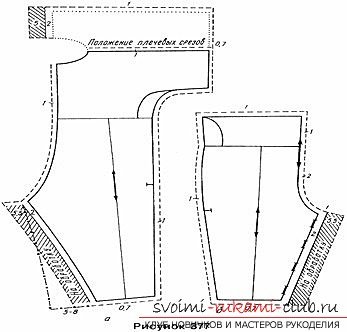
From the front side the pattern looks like this:

Cutting and sewing techniques
- Make a drawing on paper taking into account the size. Cut out the details and transfer them to the fabric, immediately marking the allowances.
- Cut out the details of the sleeves, back and front from the fabric.
- First sew the sleeves, trim the bottom.
- Connect the back and front along the sides and along the inner edge of the legs. Or, as an option, make a zipper on inside pants for easy diaper changing.
- Connect the sleeves to the main part.
- Sew on a zipper, Velcro or buttons.
- Finish the seams of the neckline and sleeve joining lines.
Pattern for fur overalls
To sew a fur jumpsuit, a base pattern is also used. You can use the drawings given above. Fur is often used to trim the hood, sleeves, and collar.
Overalls
The pattern for children's overalls for winter is presented here:
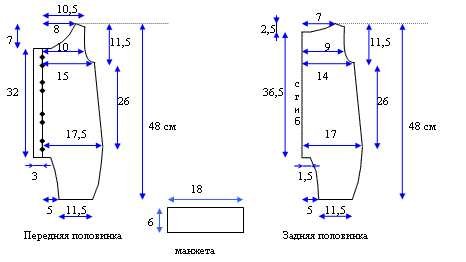
Take seam allowances of 3 cm, except for the neck (1 cm). To make it easier for the child to remove warm overalls, a zipper or buttons are sewn at the bottom.
The next pattern is for denim overalls.

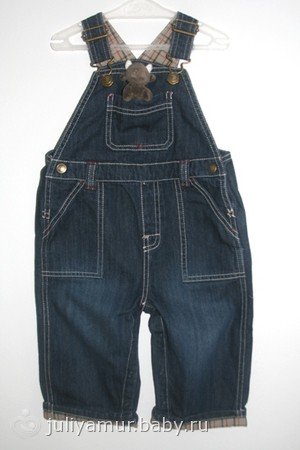
It is made with straps.
You can make a cute applique on the front.
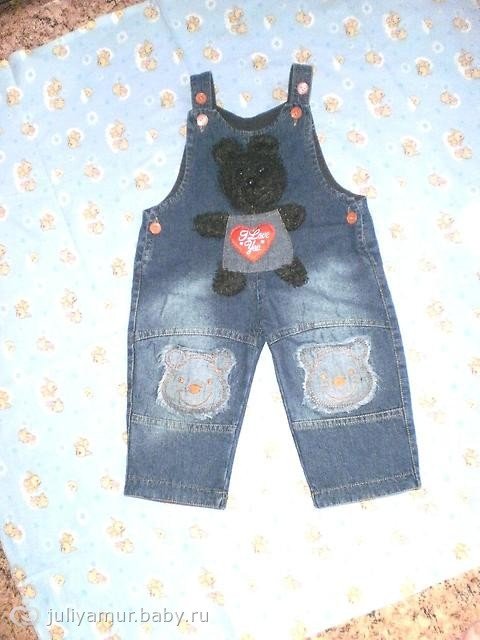
Option for denim overalls.

Children's overalls are a very comfortable and practical thing. The baby can run and jump freely and nothing will hinder his movements, and you won’t have to endlessly pull up his pants and tuck in his shirt. And besides, overalls look very beautiful on children. And if you know how to sew at least a little, it’s simply a sin not to take the opportunity and make a jumpsuit with your own hands. With love and soul. 🙂
I would like to offer several patterns for children's overalls:
- for 6 years,
- for 4 years,
- for babies 1 year old.
Print sheets of all patterns in actual size, i.e. the scale should be 100%.
Overalls pattern for a 6 year old girl
This pattern is designed for a height of 116 cm. You can download the pattern directly below the photo. To sew this model, it is best to use light cotton fabrics; it is possible to use mixed materials suitable for the warm season.
Download the pattern:

How to sew a children's overalls: brief step-by-step instructions
Step 1: Sew the shoulder seams and side seams on the bodice. Iron the allowances.
Step 2. Neck. Finish the neckline with bias tape. The video below explains simply and clearly how this can be done.
Step 3. On the sleeves sew the seams. Pin the sleeve to the armhole cut of the faces. side, aligning the seam with the side one. To do this, turn back the side seam allowances again. Sew.
Step 4. Sew the side and crotch seams on the trousers.
Step 5. Place the halves of the trousers one inside the other. parties. Sew the front and back middle stitches in one line. seams. Sew the seam allowances together and press. At the place of the step rounding, iron the seam allowances “on the edge”.
Step 6. Sew the bodice and the top section of the trousers. Press seam allowances down and stitch. Iron the hem allowances, turn them under and sew.
Overalls pattern for a 4 year old child
This wonderful jumpsuit comes with not only a pattern, but also a sewing master class.
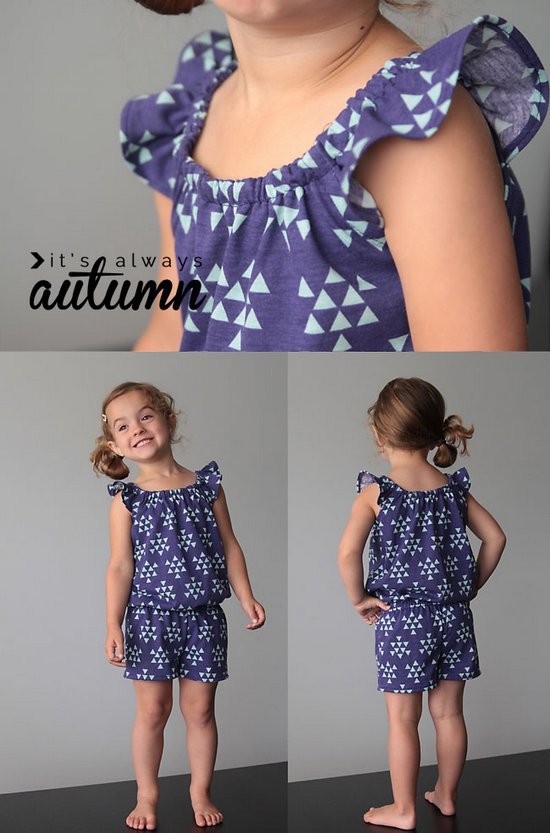
Download overalls patterns for 4 years:

How to sew summer overalls for a child: master class
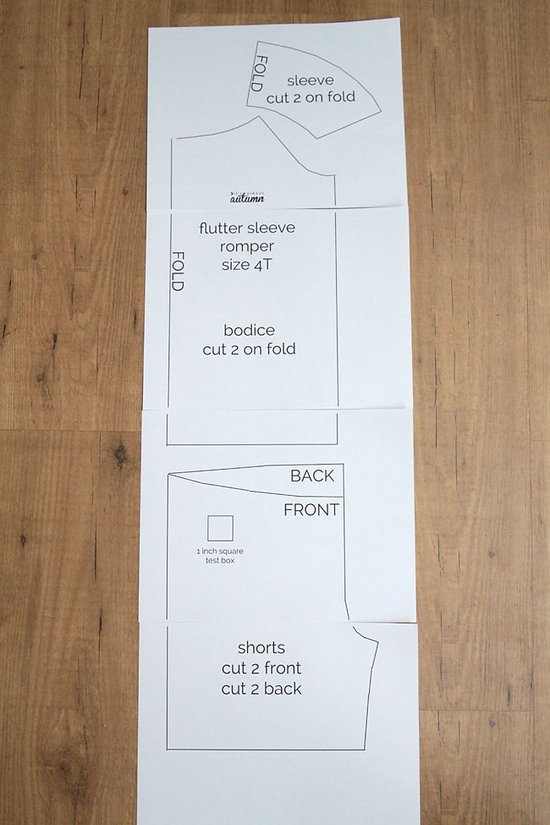
Step 1. Download and print the pattern. In the photo above you can see the result.
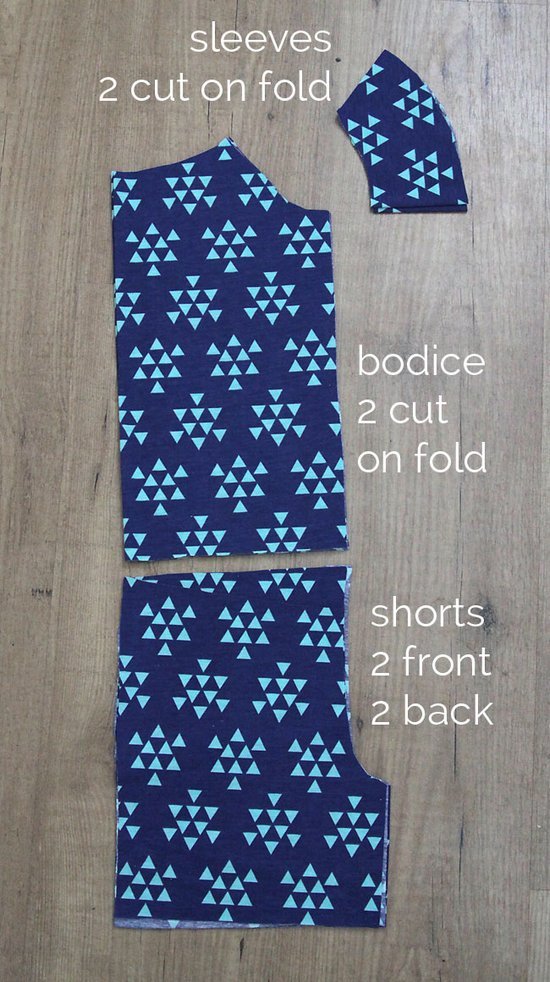
Step 2. Transfer the details to the fabric. 2 top parts. 4 parts of shorts - 2 front parts and two back parts.
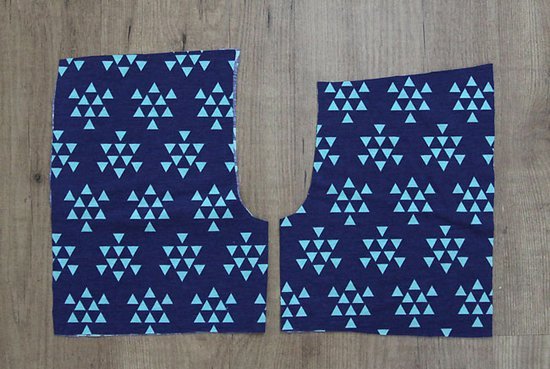
Please note that the back of the shorts is higher than the front
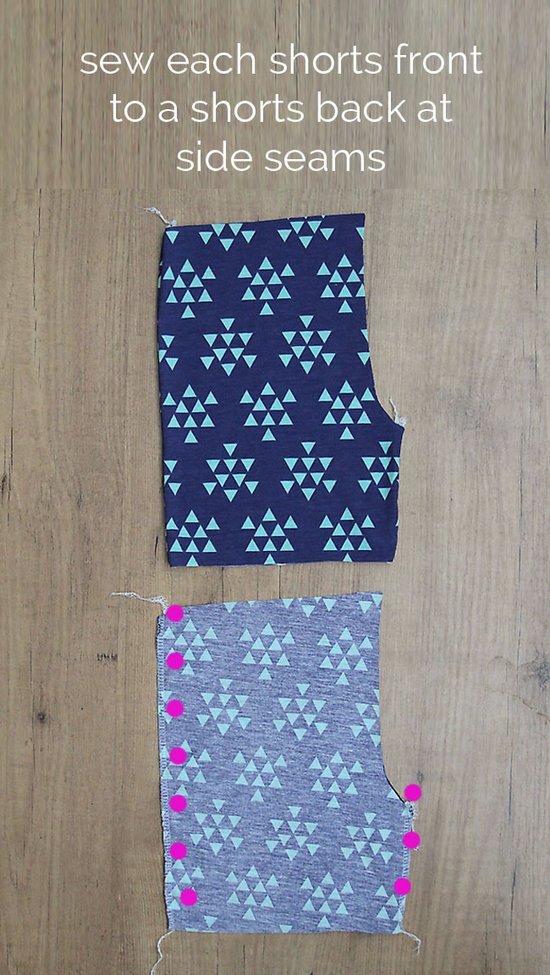
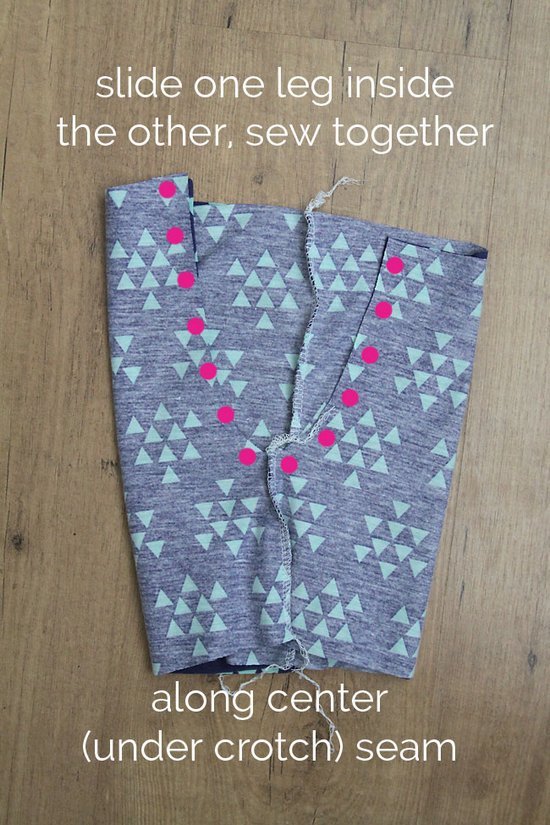
Step 3. Sew the seams on the shorts.
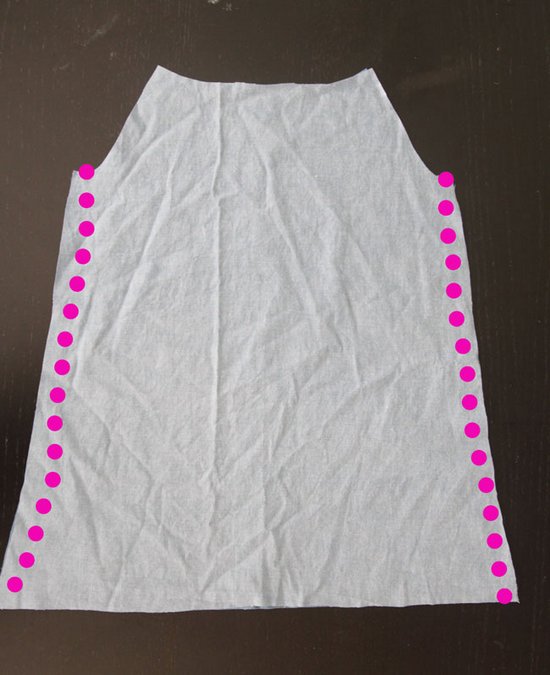
Step 4. Sew the side seams on the top of the jumpsuit (using the example of a dress using a similar top pattern).
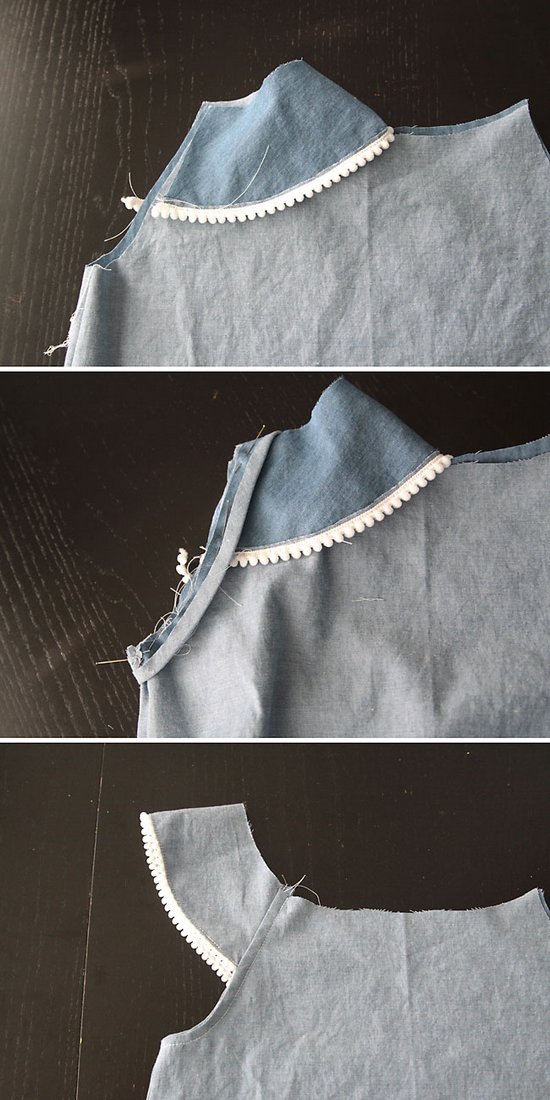
Step 5: Sew in the sleeve.
